AC Milan held onto a 1-0 lead to beat Napoli in Matchday 24, ending a decade-long hoodoo against the Partenopei in terms of home league games.
A Theo Hernández goal in the 25th minute secured the three points, in a game of few high quality chances. The visitors had a higher share of possession (57%) across the ninety-minutes but an organised and cohesive Rossoneri limited their opponents to two shots on target and a xG of 0.87.
Here’s @Tactics_Tweets to provide some tactical observations on the win which took Milan to 52 points – one behind second-placed Juventus and eight behind league-leaders Inter.
Classic underlap
Speaking post-match, Napoli manager, Walter Mazzarri, said of the game’s only goal: “It was predictable, it’s a classic Milan action.” But despite the apparent awareness and expectation of this trademark Leão-Hernández combination, Napoli were unable to stop it.
And in a game where quality attacking play was seldom, Milan’s first half breakthrough was a standout moment which deserved the honour of being labeled ‘match winner’. To make matters worse for the visitors, not only would they have been aware of this threat ahead of the game, but they also had warning signs in the opening twenty-minutes too.
The first example was in the 8th minute. Napoli were on the attack, and as such their wing-backs, Giovanni Di Lorenzo and Pasquale Mazzocchi, had advanced higher up the pitch.
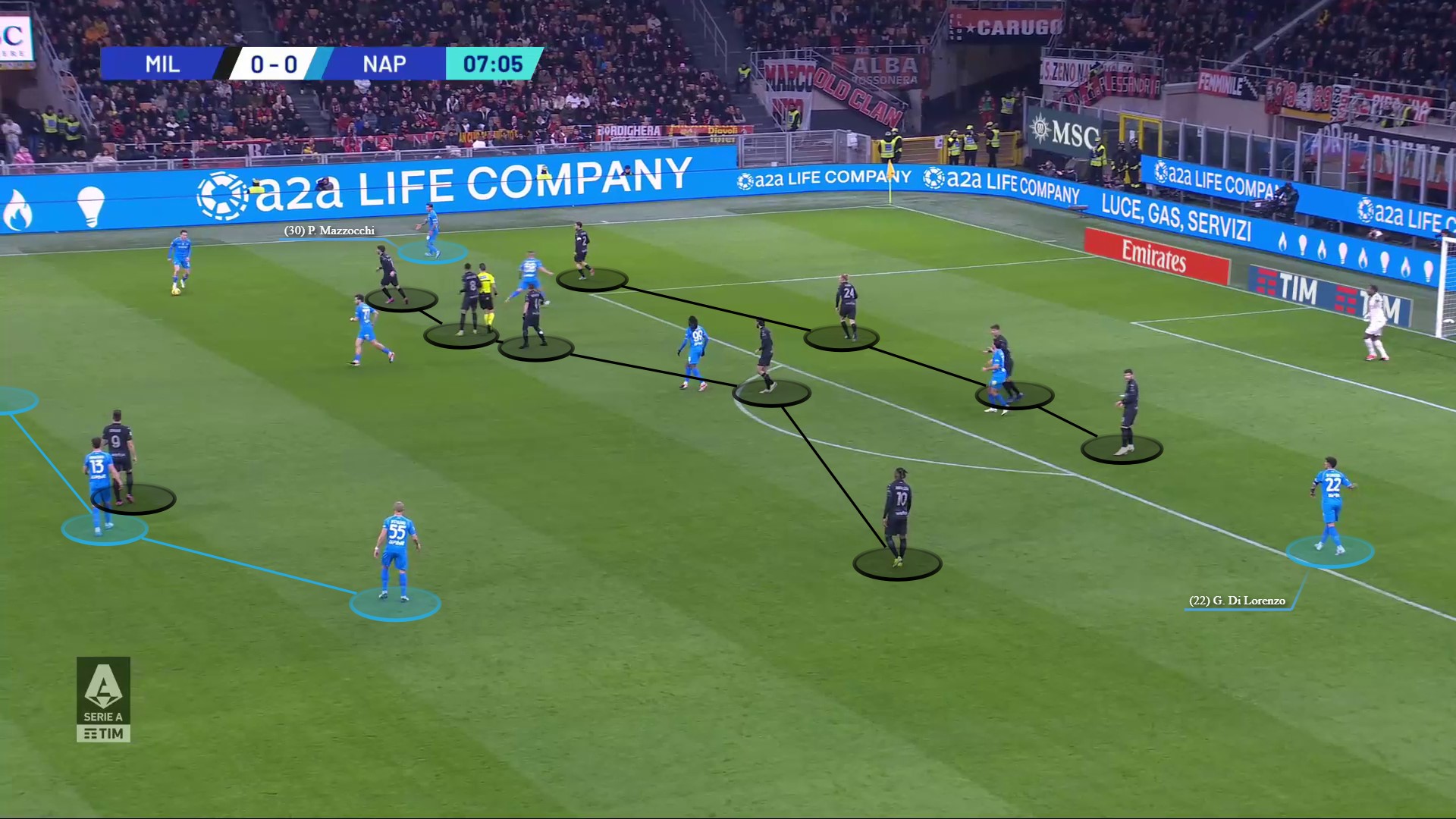
But after losing possession in the final third – through an advanced Amir Rrahmani too, exasperating the issue – Milan were able to attack an exposed Napoli backline.
With Leo Skiri Østigård pushing out wide to deal with Leão (and Rrahmani caught upfield) there was a gap inside for the underlapping Hernández to penetrate. See below how Di Lorenzo was unable to retreat in time and how Stanislav Lobotka, despite being initially goalside at this point, was unable…
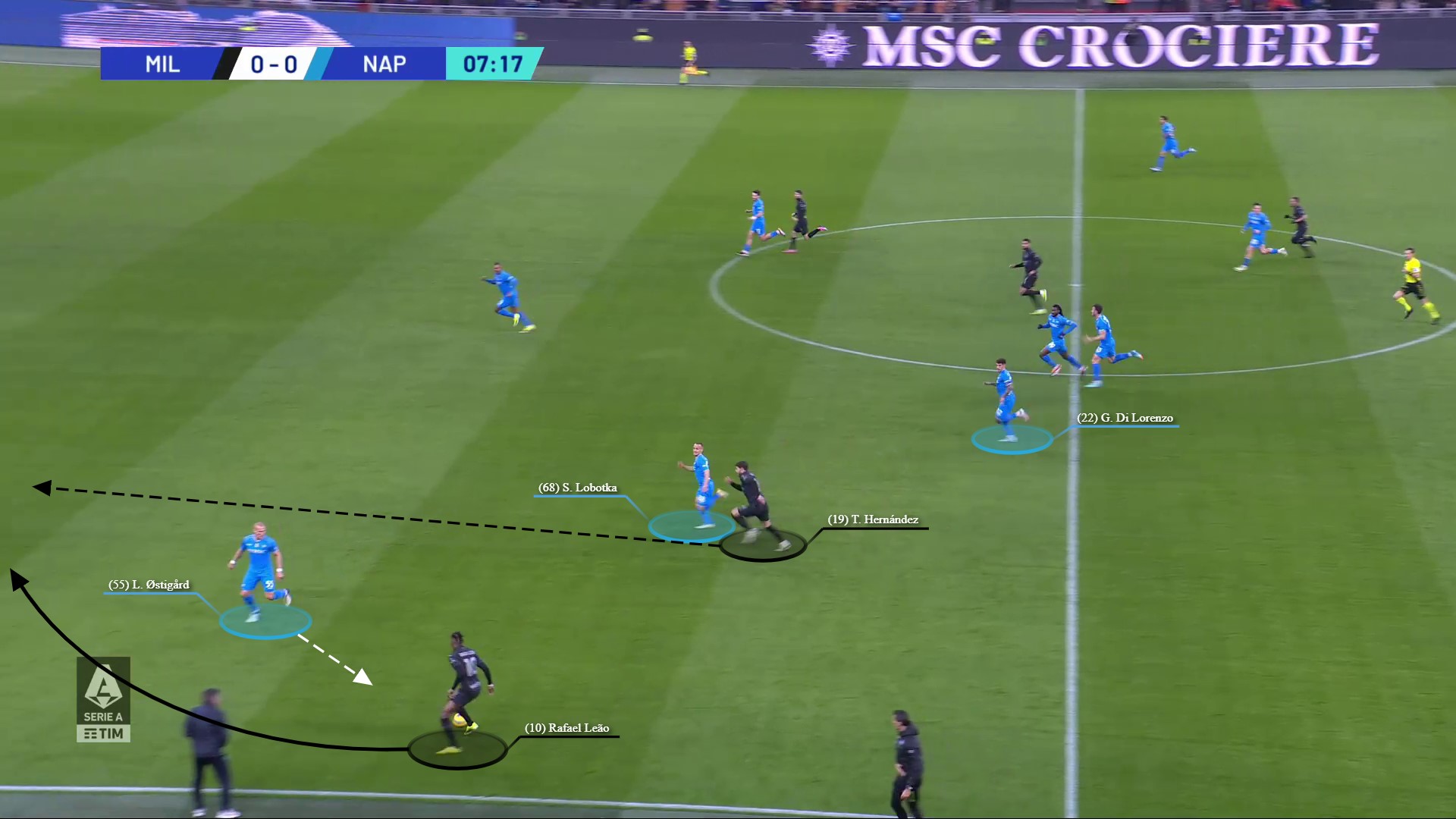
…to keep pace with the French full-back. Fortunately for the visitors, Leão’s pass in behind lacked care and sent Hernández wider than necessary, meaning Milan were unable to take advantage of an unorganised Napoli.

Hernández still managed to dig out a cross into the box but by this time, Napoli had retreated bodies to defend – and besides, Loftus-Cheek’s header lacked any direction or power.

In this next example, from the end of the 12 minute, Milan had first-phase build-up so formed their 4-2 substructure with both full-backs intentionally deep and wide.
In defensive phases, Napoli used a 5-3-2 formation but due to the positioning of the Milan full-backs, when the visitors attempted to engage the hosts high their ball-sided wing-back would be primed to jump and close down the opposition full-back – as per Di Lorenzo in the visual below who was now in the process of retreating on the account of Milan switching play to the opposite flank.
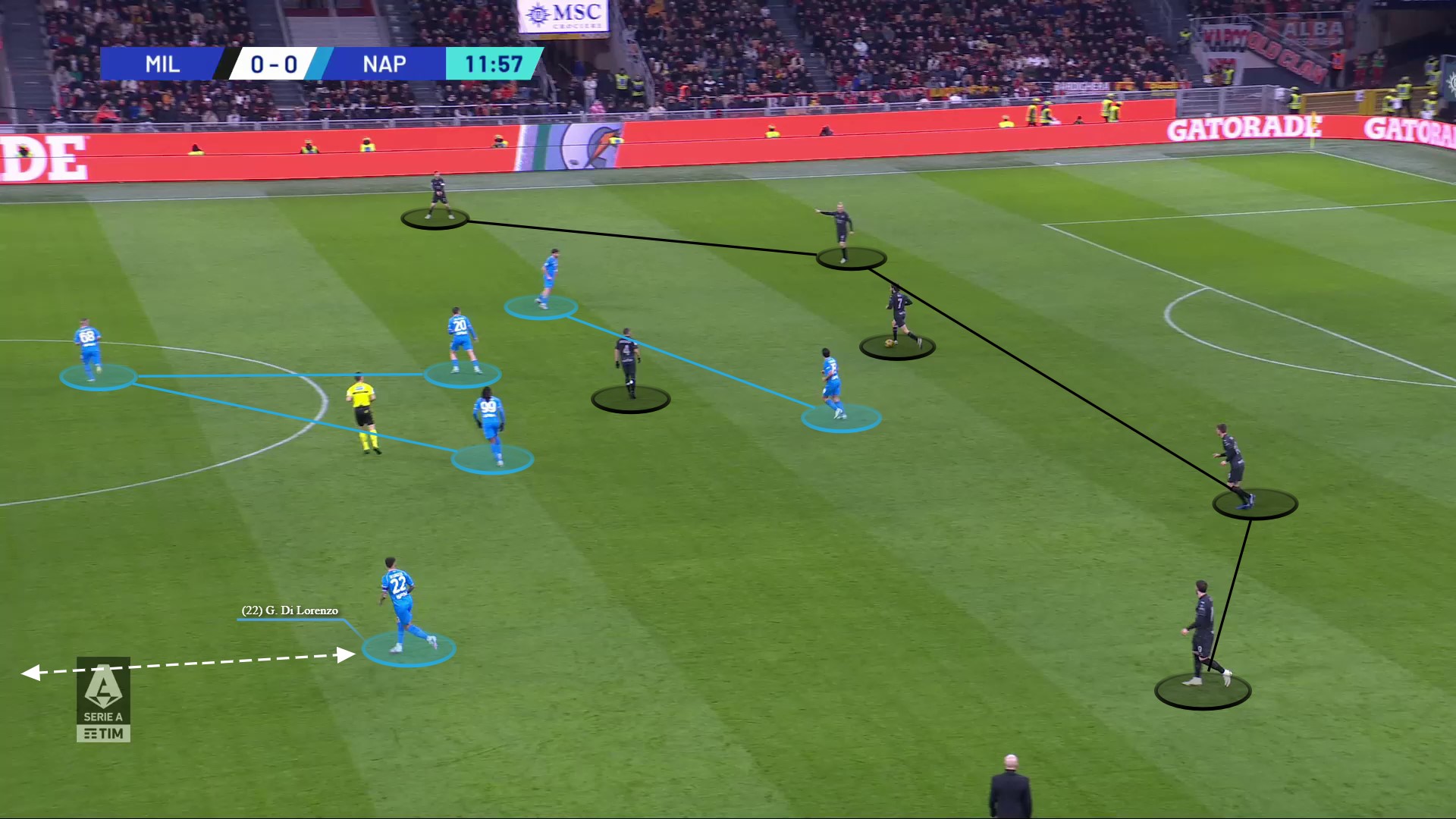
After Milan progressed possession into the final third, an advanced and infield Hernández spotted an opportunity to make another penetrative underlapping run.
With Di Lorenzo focussed on Leão out wide and Østigård momentarily preoccupied by Loftus-Cheek, Hernández attempted an off-ball run (on blindside of Lobotka) to exploit a brief opening in the Napoli backline.

However, on this occasion, Østigård recognised the threat and dropped off to intercept the Leão pass to Hernández with an outstretched leg.
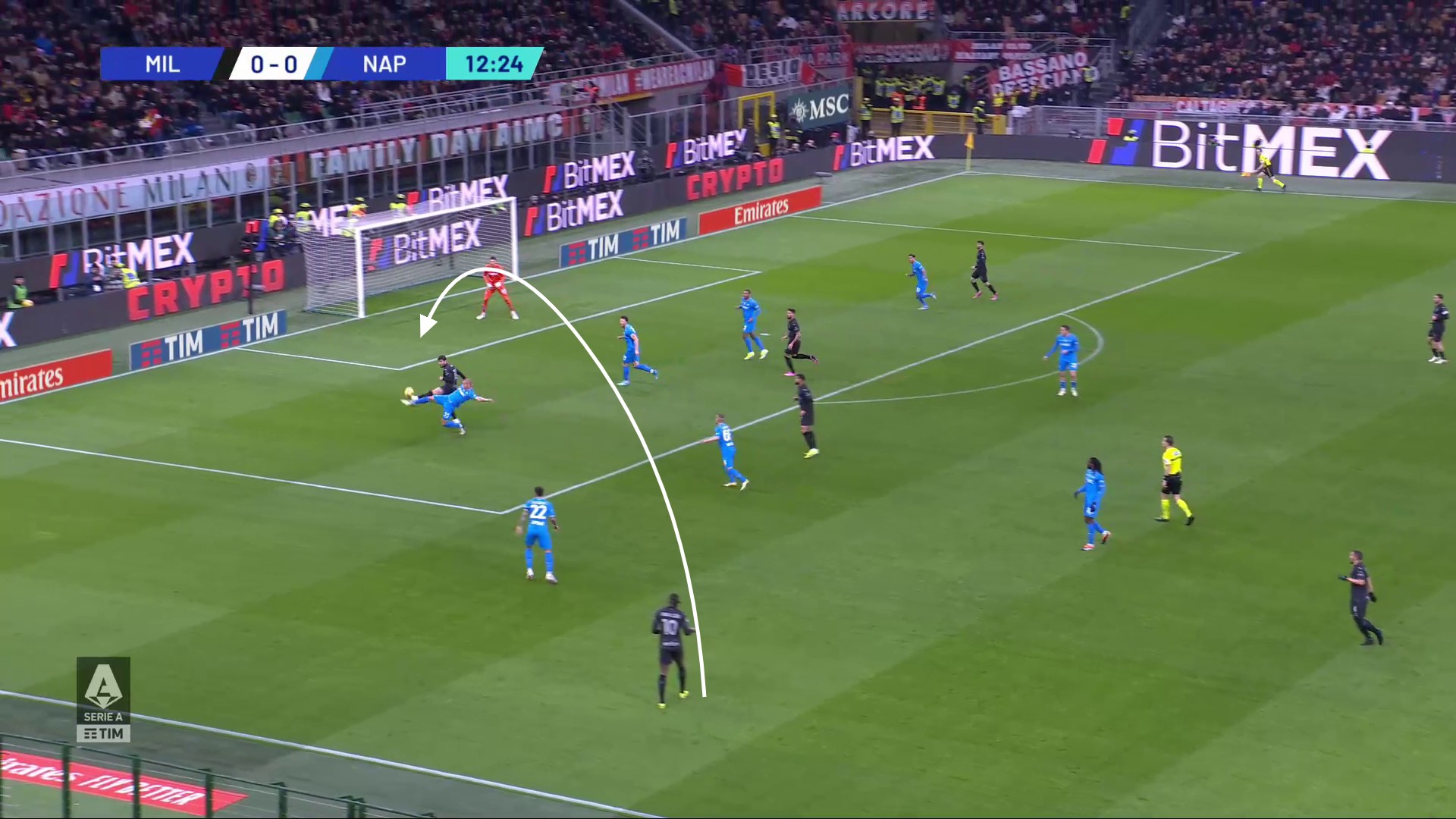
Here in the 15th minute, Milan had pushed Napoli back into their low block. With Leão holding the width on the left wing, Di Lorenzo had edged across to close the distance to the Portuguese attacker.
As Hernández had shaped to cross, Østigård narrowed his defensive position to avoid allowing his centre-back partners a 2v2 against Giroud and Loftus-Cheek in the event of a ball into the box. As a result, a gap appeared in the Napoli backline.

Instead of crossing, Hernández laid the ball off to Yacine Adli who in turn passed inside to Ismaël Bennacer and simultaneously, Hernández made his underlapping run into the aforementioned ‘gap’ with Lobotka passing on the French international in the process.
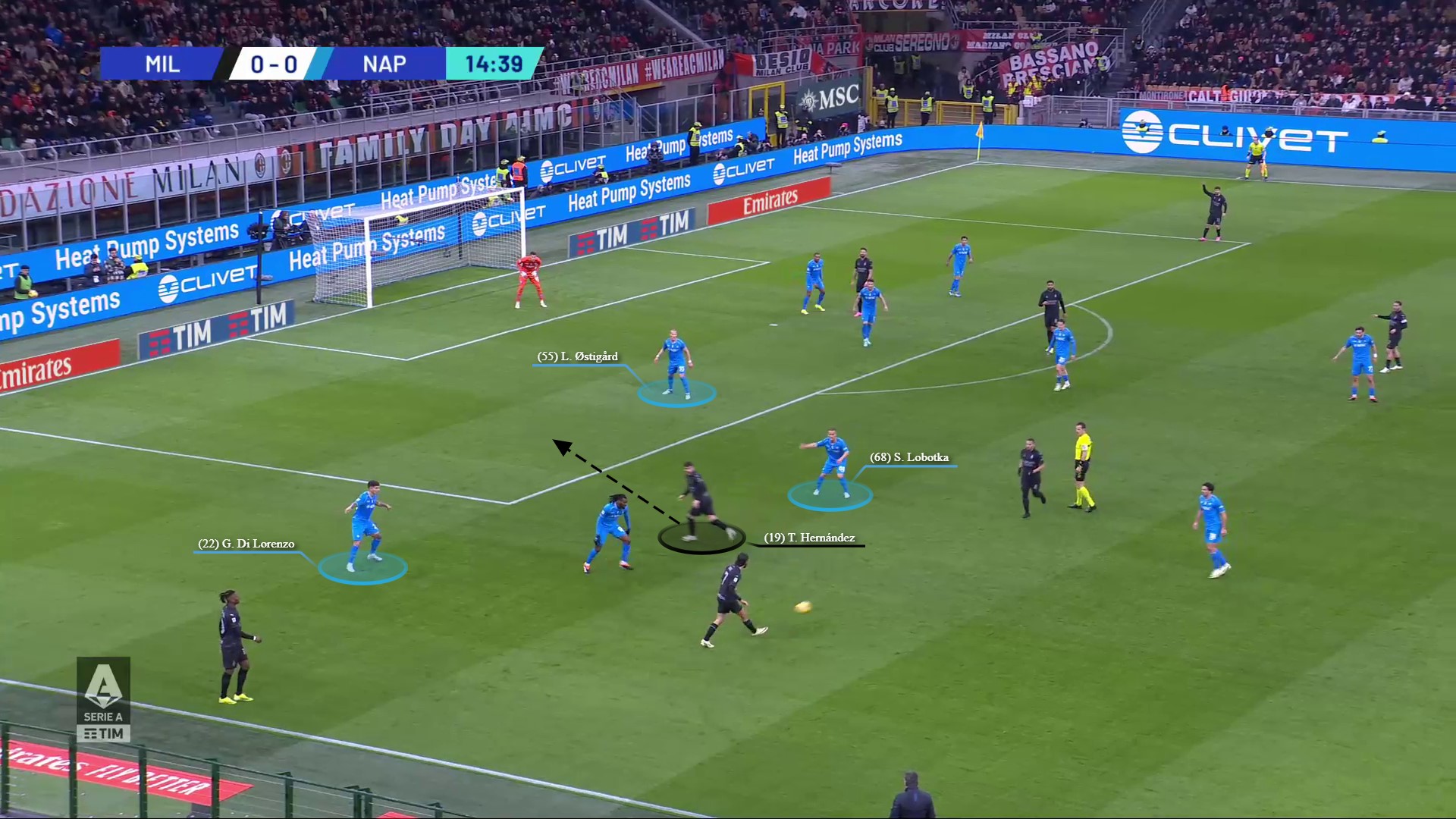
Milan were unable to find the passing angle into Hernández, with both Di Lorenzo and Østigård reacting to deny this space.
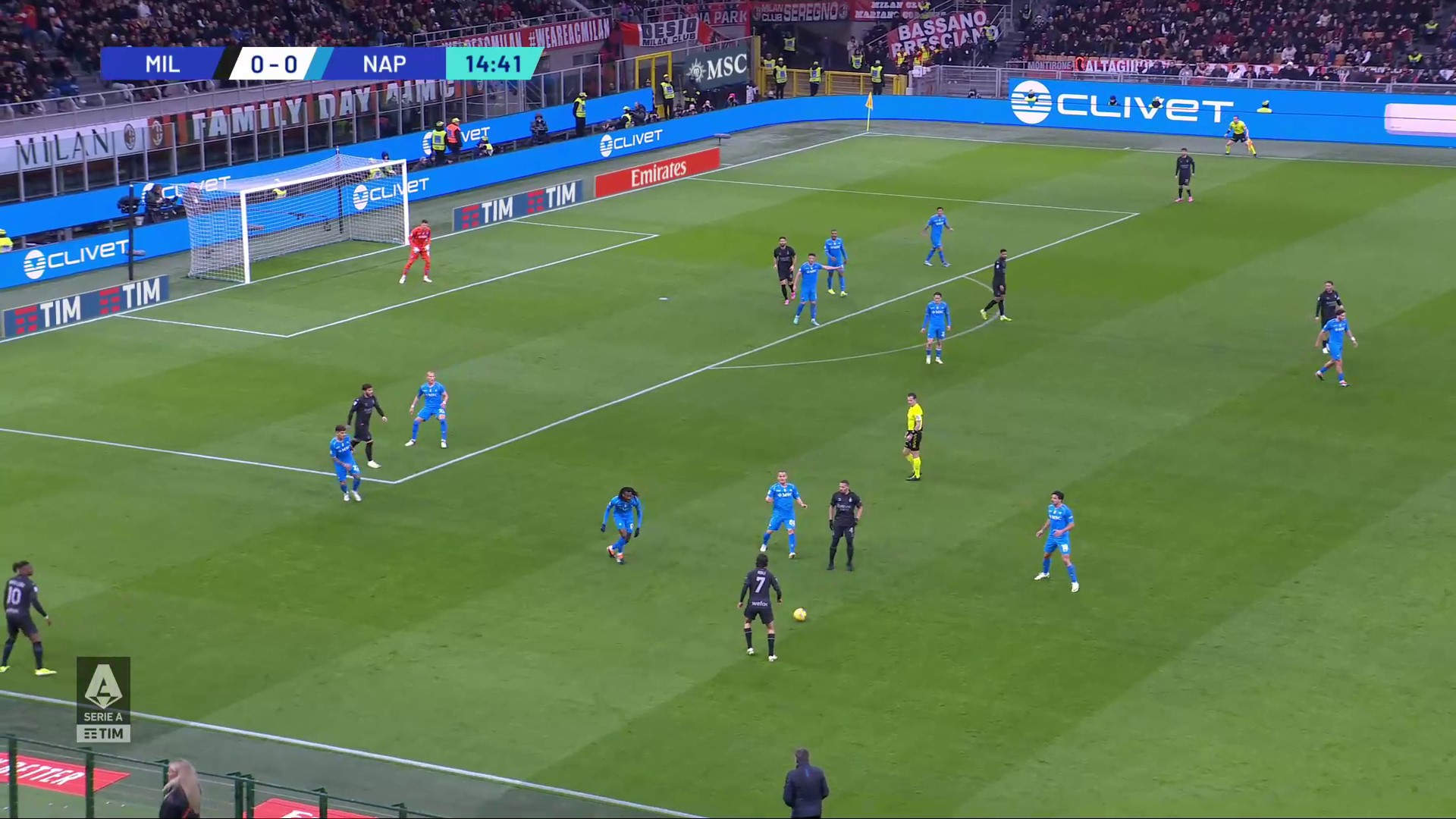
But in the 25th minute, Milan’s (and Hernández’s) persistence paid dividends. The sequence began with Milan in build-up. An Adli pass to a deep and wide Hernández triggered a Di Lorenzo jump – the first displacement in the Napoli backline. Also note, Giroud’s starting position, ball-side of his marker Rrahmani.
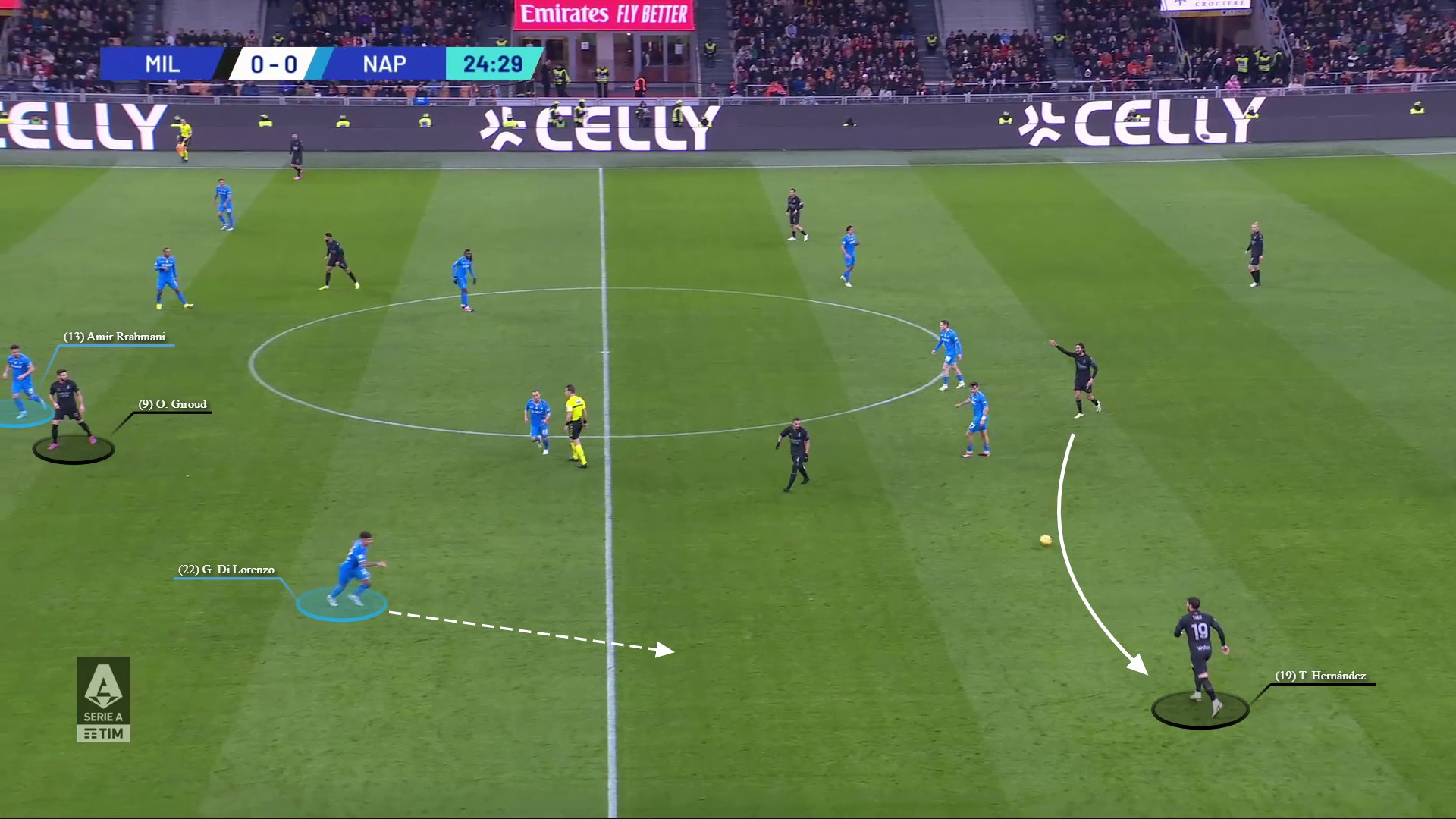
After receiving, Hernández laid a pass into the feet of Giroud who had dropped short to receive, dragging Rrahmani out of the Napoli backline in the process – the second displacement in the back five. Like clockwork, the French centre-forward played a first-time pass out to the wide Leão who was closed down by Østigård – the third displacement.
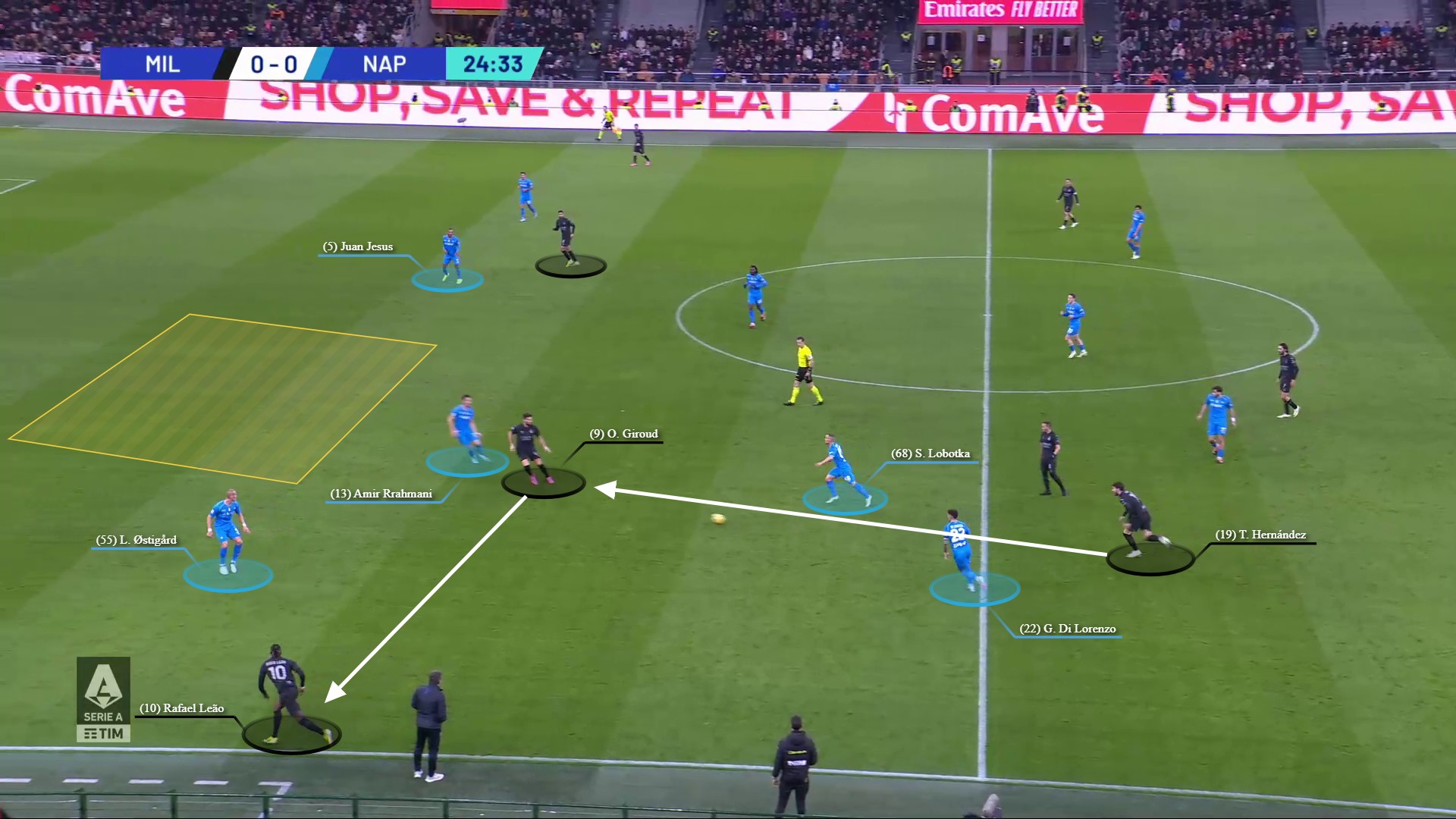
In the image above, you can see how immediately after playing the pass to Giroud, Hernández was continuing his momentum with a forward (underlapping) run.
This meant that once Leão received the ball, Hernández was ready to exploit the space and complete the third-man combination – see below, and Lobotka trying to keep pace.
A final observation to appreciate in this screenshot is how Giroud made a wide run after his pass, helping maximise the space in the Napoli defence. An unselfish and important detail in this action, and a sign of his game intelligence – as Hernández has the pace to penetrate this space, whereas he doesn’t.
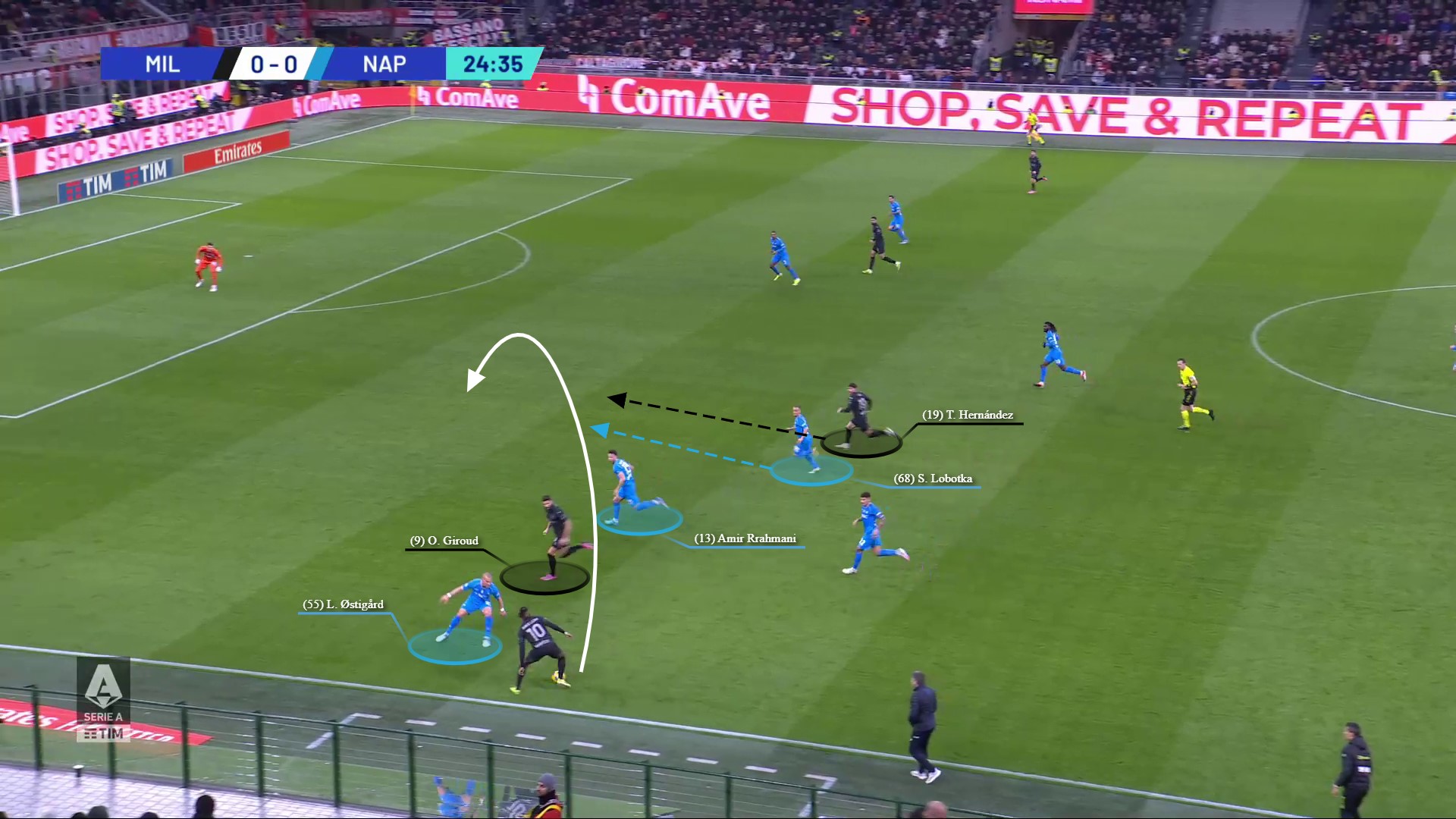
The outcome, a Leão shimmy to get onto his right foot and then a perfectly timed and weighted pass into the free Hernández (Lobotka long gone and Juan Jesus did not move across to cover either) to slide the ball into the back of the net past Pierluigi Gollini.
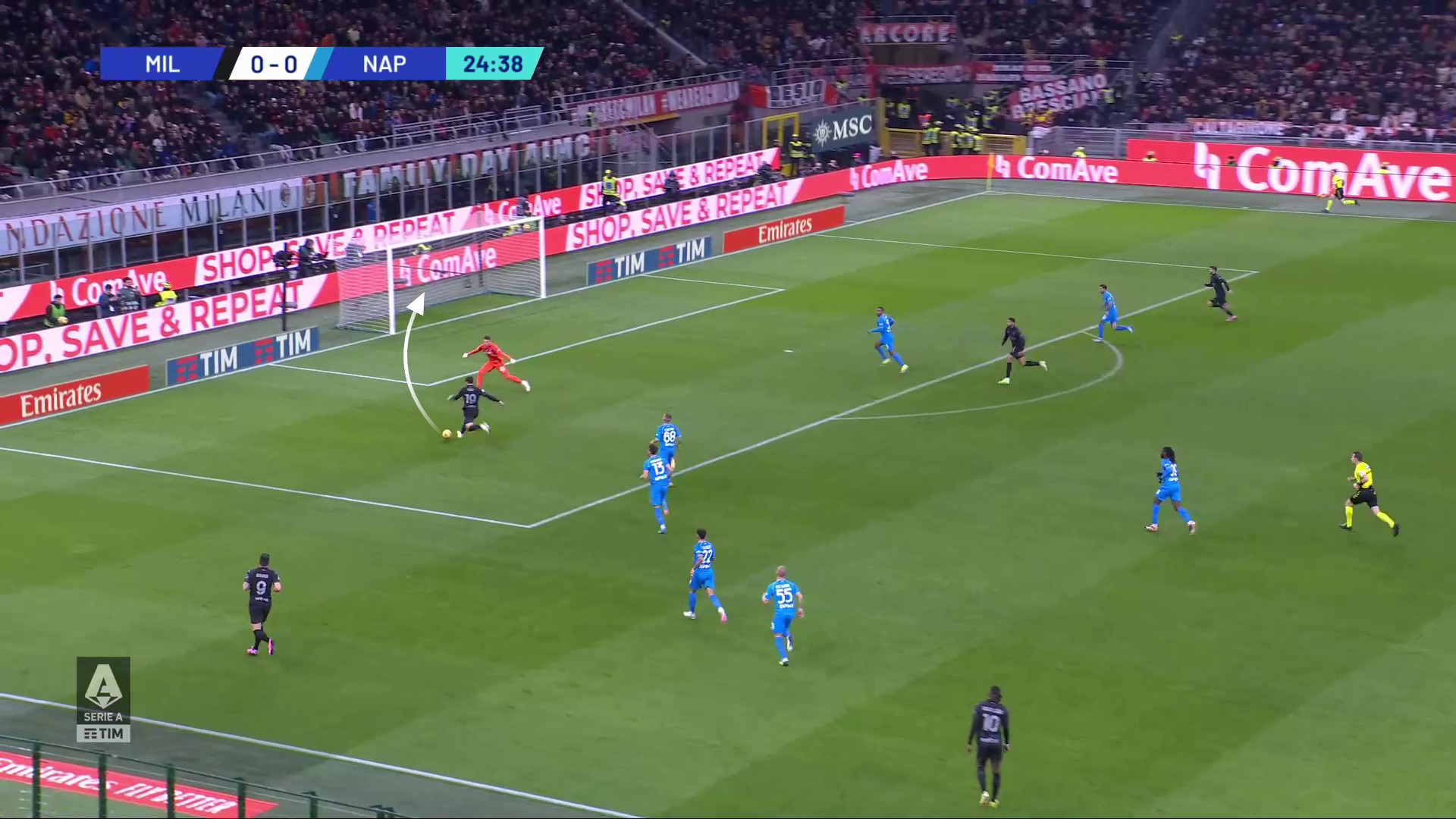
Whilst this passage of attacking play led to the decisive moment of the game, across the ninety-minutes Napoli had the majority of the ball (57%) and therefore Milan’s victory required frequent periods of defensive work.
This clean sheet was Milan’s first in five matches, across all competitions. But was the shut out more down to the home team defending well or Napoli attacking poorly?
Defensive balance and order
Pioli was asked about his side’s defensive shape after the game, to which he gave the following succinct response: “It was a balanced, orderly Milan.”
And apart from Giovanni Simeone’s chance in the 10th minute – when Milan lost possession from their own throw-in, in their own third – and substitute Jan-Carlo Simic inadvertently directed the ball onto his own post when defending the six-yard box in the 89th minute, the home team were organised out of possession and adjusted efficiently and effectively to the issues Napoli tried to cause them.
Across the two halves, Milan had to contend with two Napoli systems. In the opening forty-five minutes, Mazzarri sent his team out in a 3-5-2 attacking shape with Khvicha Kvaratskhelia playing off Giovanni Simeone.
In addition to trying to exploit their use of width, through their wing-backs, Napoli’s other main attacking tactic revolved around their Georgian attacker dropping into midfield areas to find pockets of space, create potential overloads and interchange with the likes of Piotr Zieliński, Frank Anguissa and Stanislav Lobotka.
To deal with this, Milan made some slight adjustments to their usual out of possession system, but a number of their usual tactics remained.
These included, against settled possession, aiming to maintain a +1 in their backline (one more defender than the number of opposition forwards) and central midfielders having player-orientated responsibilities.
Then, in their pressing scheme, Milan were prepared to go man-for-man, with specific players having roles to maintain balance and cover in case the press was beaten.
As opposed to the usual 4-2-3-1 looking-formation without the ball, against Napoli, Milan’s (1st Half) set-up resembled more of a 4-3-3 with Loftus-Cheek positioning himself in closer proximity to his midfield partners, Bennacer and Adli.
To deal with the opposition wing-backs, the ball-sided Milan full-back would jump to engage, with the opposite full-back staying deep to provide cover in the backline – in essence, engaging the ball-side and allowing a weak (opposite) side.
A key aspect of Milan’s out of possession plan was Giroud’s role in positioning in front of Lobotka. The Milan striker aimed to use his cover shadow to block passes into the Napoli midfielder, and this enabled Loftus-Cheek to maintain a deeper position to help provide cover where needed.
Here are some examples demonstrating all of the above descriptions in visual form – starting with this sequence in the 18th minute that involved over a minute of Napoli possession but Milan managing the situation in an ‘orderly’ manner.
Rrahmani, middle centre-back, had possession which Milan were happy to allow, instead prioritising forming their high block. The forward line of three, had dropped off to block passing lanes into midfield and Giroud was using his cover shadow to specifically prevent access into Lobotka which allowed Loftus-Cheek to be an in-between player defensively.
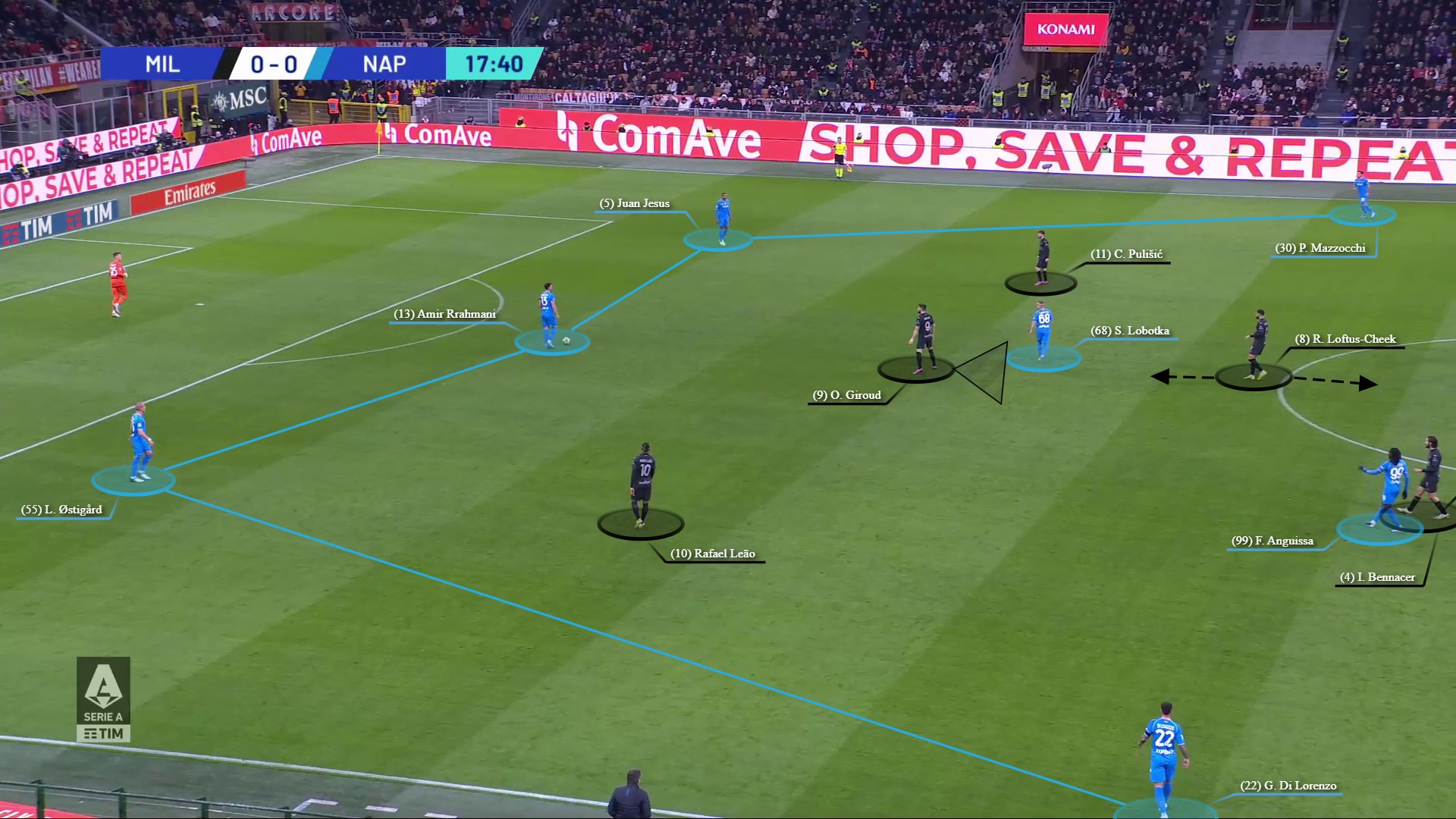
Whilst Napoli’s wing-backs usually stayed wide, in this instance, Di Lorenzo inverted infield to receive a pass through the lines. But right on cue, this was Hernández to jump and engage.
Below, you can also see how Kvaratskhelia had dropped to add an additional body in central midfield (overload) – which began to explain why Loftus-Cheek keeping himself initially unattached was important.

In this spell of possession, Napoli worked the ball from side-to-side and executed a number of midfield rotations (see new locations of midfielders below) before passing the ball to Di Lorenzo on their right flank.
Here, you can now see Milan in their pressing scheme, with all players man-for-man. As Hernández had jumped to engage Di Lorenzo, on the far-side of the pitch, Calabria had dropped to maintain coverage in the backline.
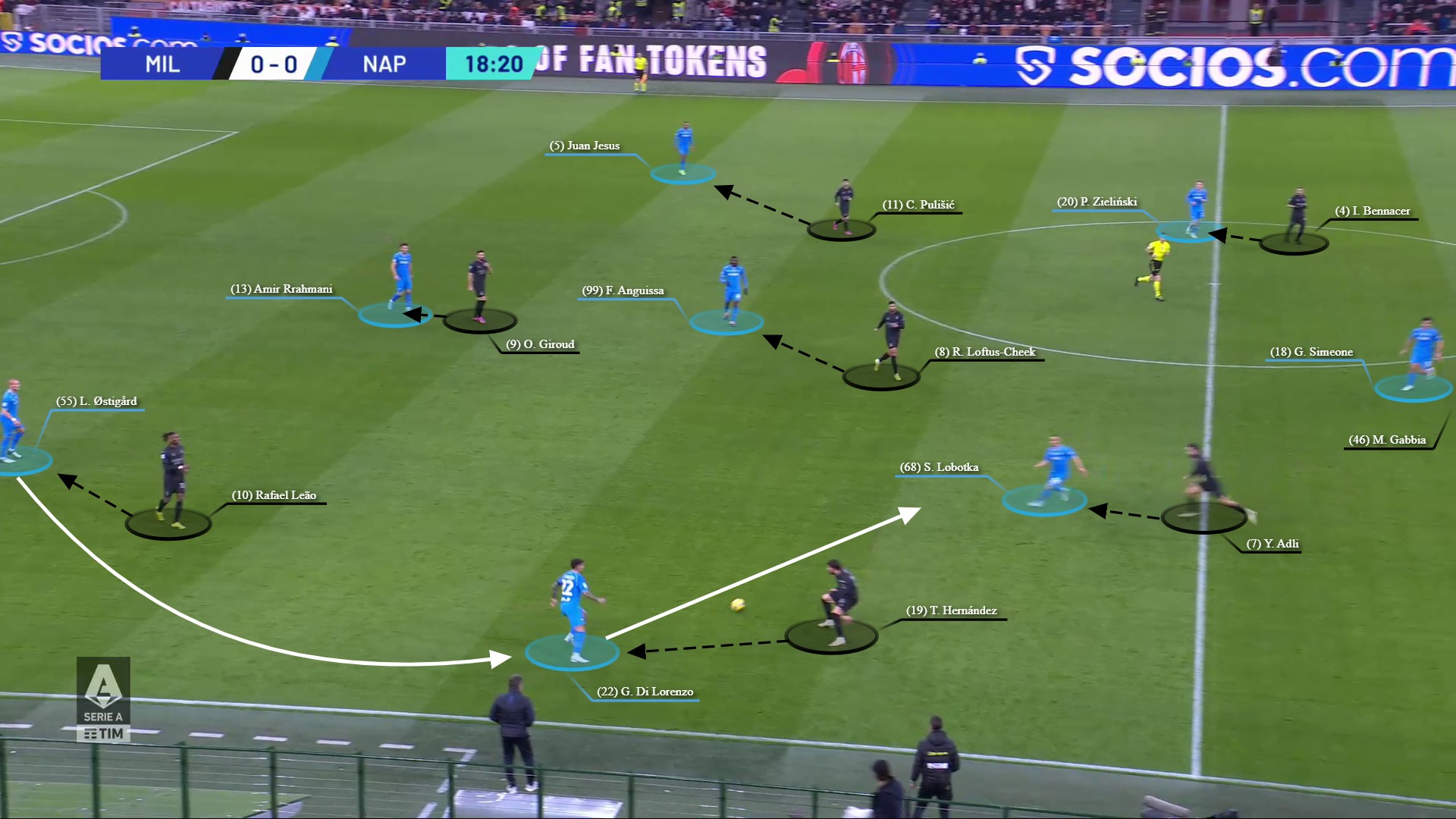
For the next twenty seconds, Napoli maintained possession, executed further rotations (Zieliński swapped sides), before switching play to their left wing.
The action picks up below with the now ball-side full-back, Calabria, jumping to engage his opposition wing-back, Simon Kjær stepping out to pick up the free Kvaratskhelia, and Loftus-Cheek and Adli recognising the potential danger so beginning to drop as cover.
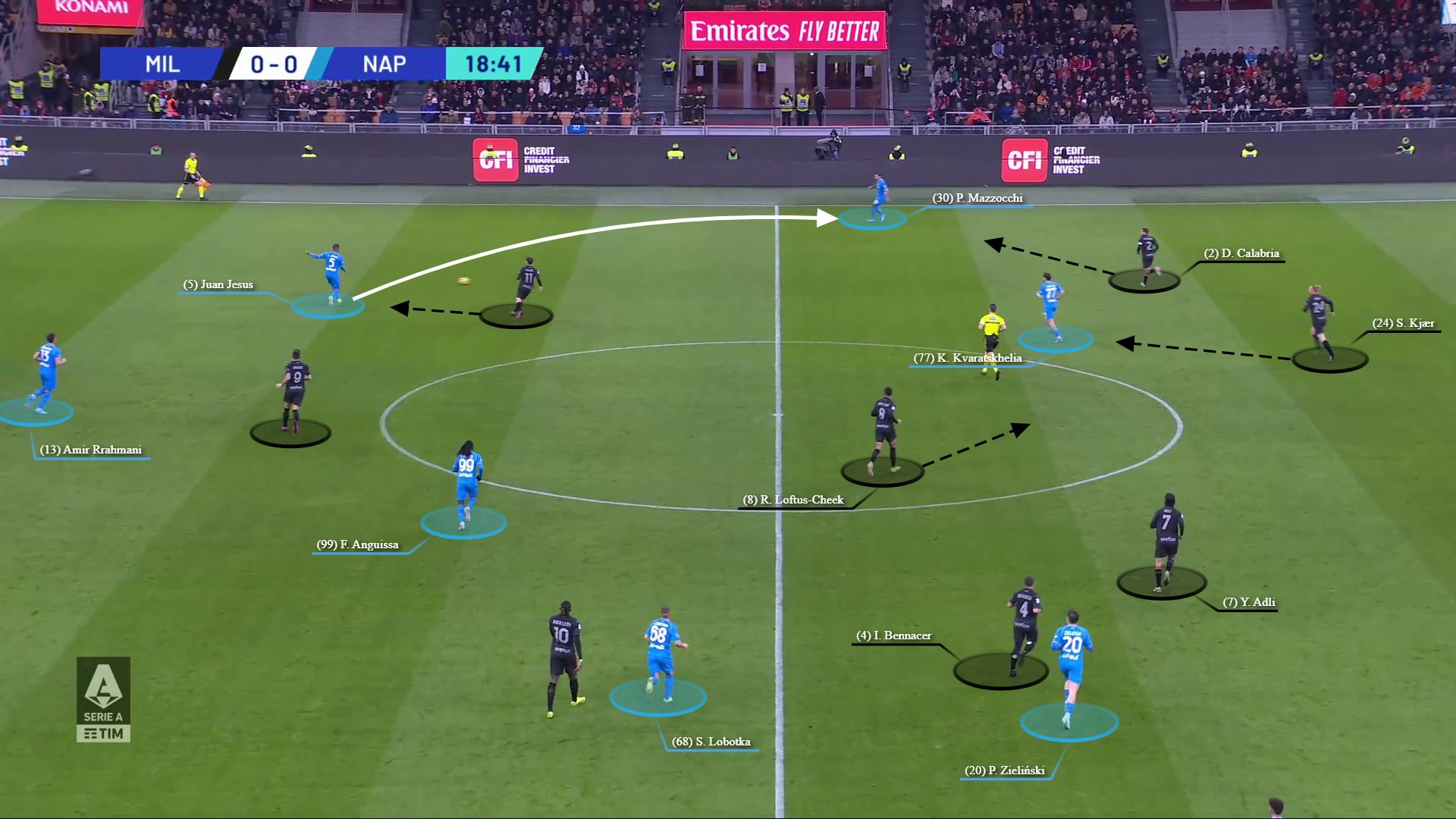
In a perfect example of Milan players reacting when specific opponents received the ball, the hosts circled, and outnumbered, Kvaratskhelia, after he received the ball.
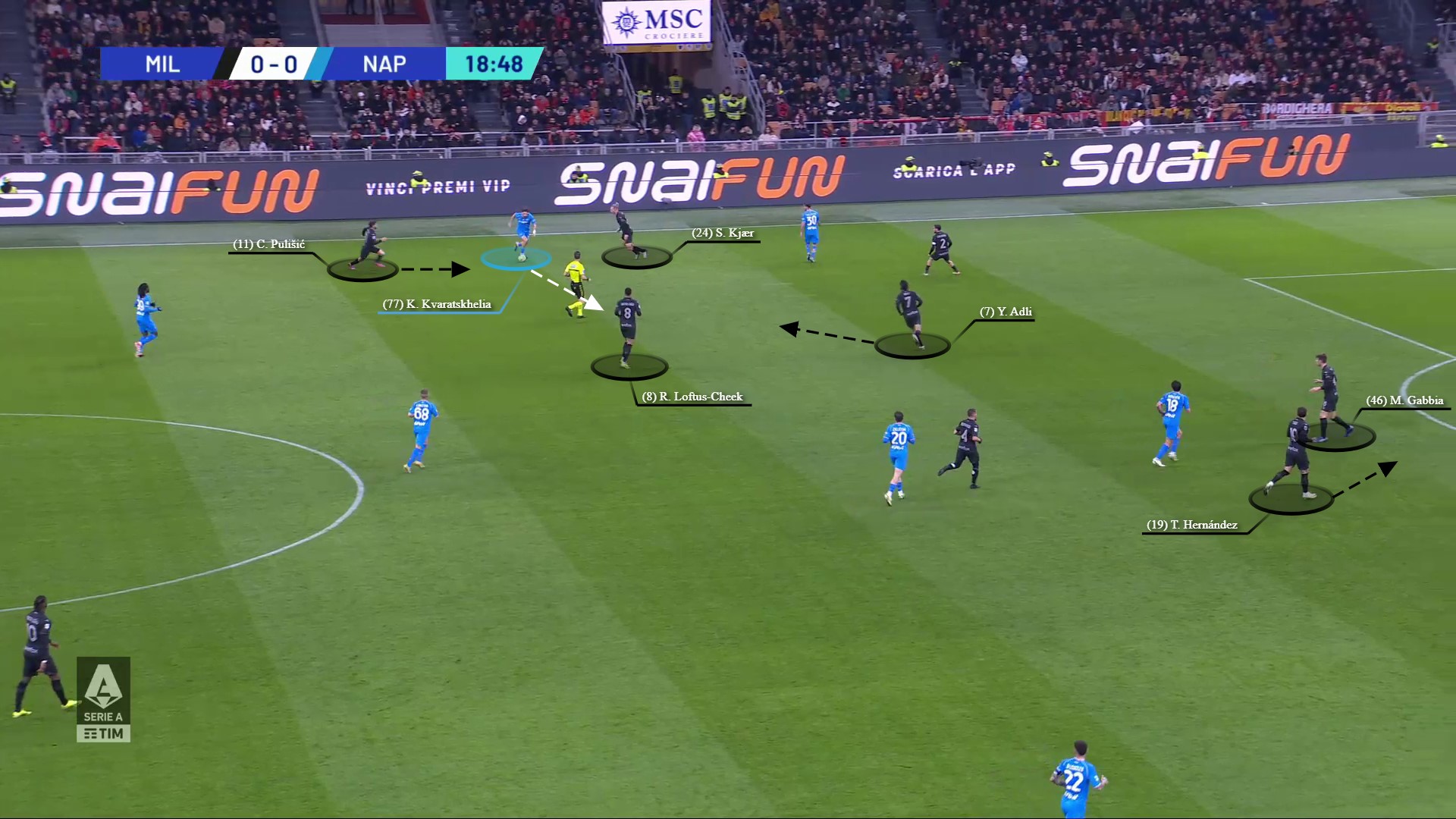
The above sequence concluded with an initial fleeting turnover before blocking a subsequent Napoli cross that conceded a throw-in, enabling the team to get back into a fully organised shape. (Also observe in the previous image how Hernández was in the process of dropping to provide coverage in the backline, with the ball on the far-side).
And throughout the first half, these tactics out of possession continued. This example from the 27th minute again shows Milan in a high block – Giroud blocking access into Lobotka, Bennacer tracking the dropping Zieliński, Hernández on the retreat having initially jumped to close down Di Lorenzo and Loftus-Cheek spare (thanks to Giroud’s role) so able to scan for any potential threat behind him.
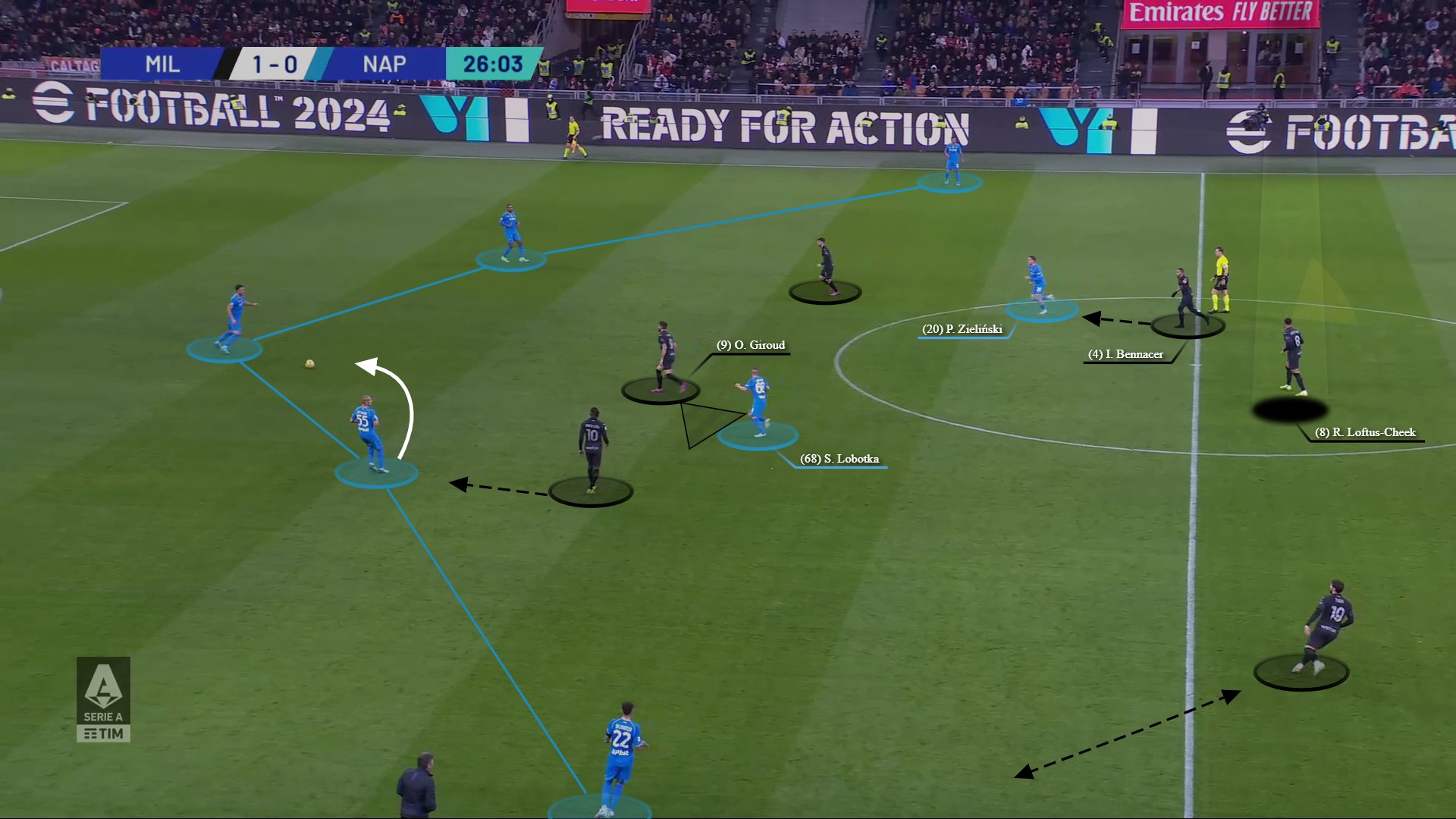
Once Napoli worked possession over to their left flank and Mazzocchi (left wing-back), Calabria jumped, meaning Hernández dropped on the far-side.
With Loftus-Cheek having seen Kjær pushed out to cover Kvaratskhelia, the English midfielder began to drop deeper to provide cover, but he was quickly forward-facing again as Calabria’s pressure had actually forced Napoli backwards.
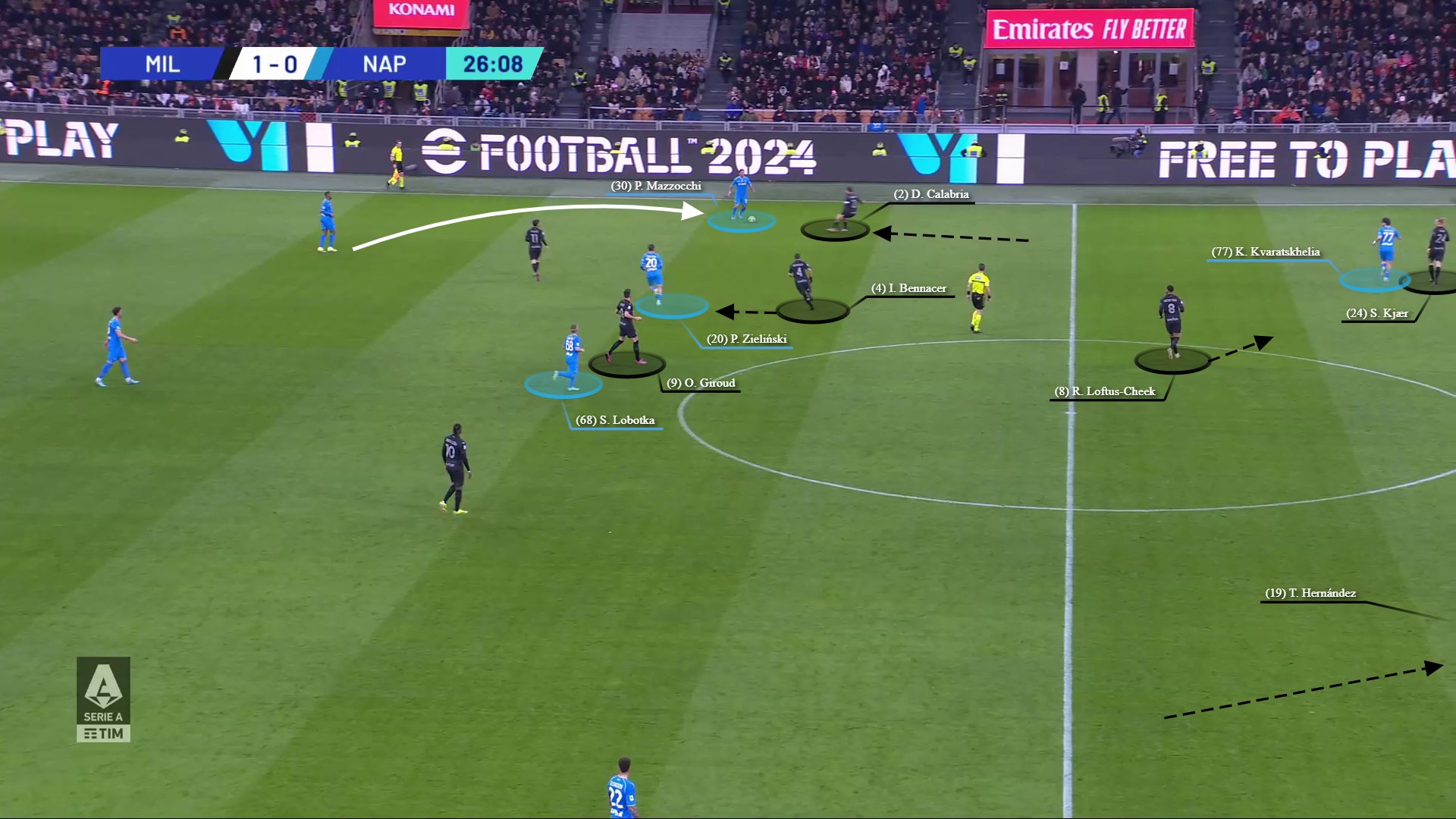
With no entry down the Milan right-hand side, plus all central options closely marked, Napoli attempted to progress down the Milan left, but – as per the famous Louis van Gaal “steering wheel” analogy – when one full-back pushes forward, the opposite full-back needs to drop back.
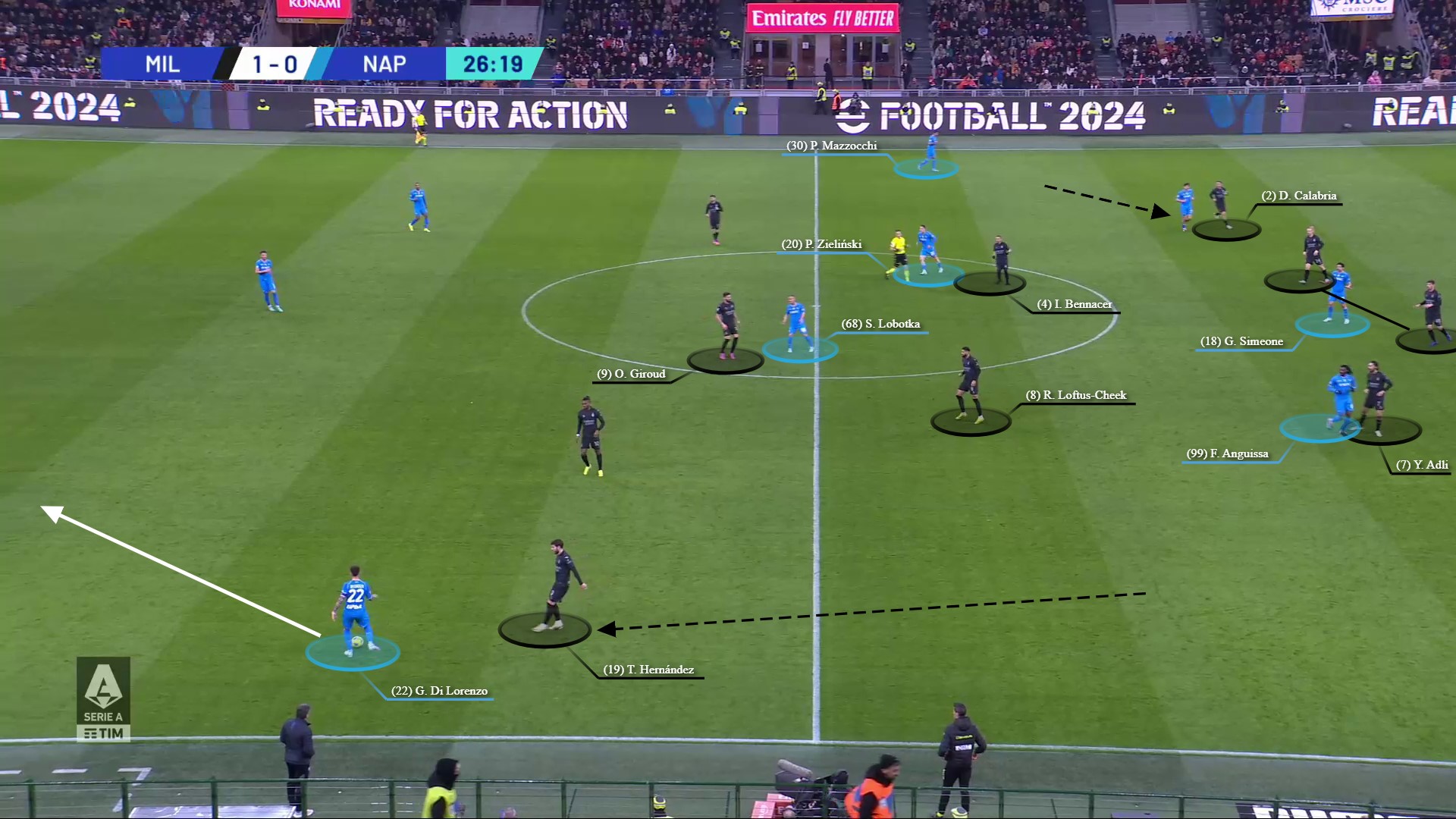
After getting frustrated with their lack of progress, after working the ball back over to their left flank, Napoli attempted a more direct pass towards their forward line – and to get up the pitch – but here’s where Milan +1 in their backline came in handy, as a free Gabbia was regain possession and set his team up on an attack
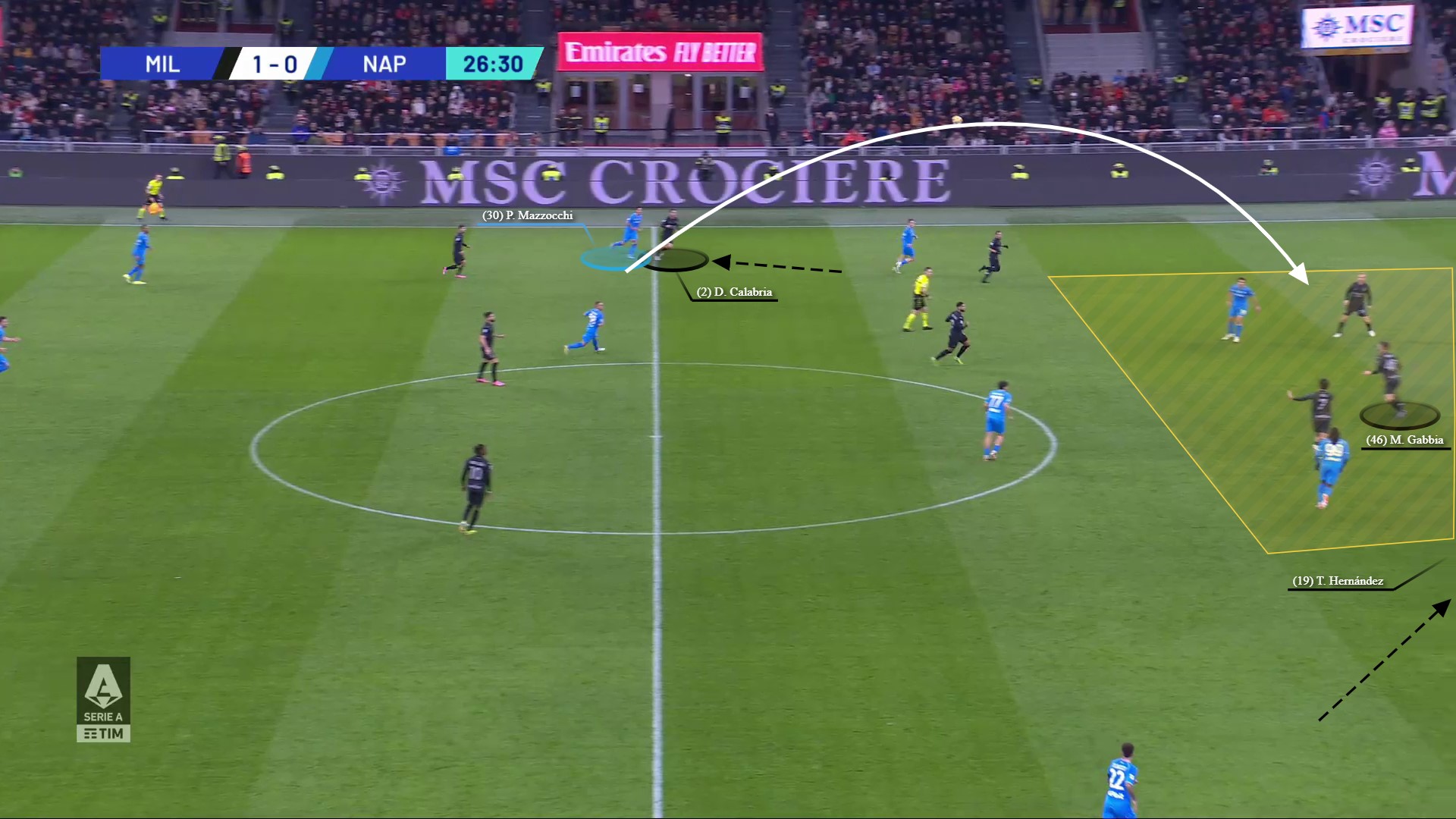
Here’s a final example from the opening period, where Calabria’s jump forced a turnover. This passage of play has been included as it shows Milan’s pressing-scheme.
Giroud released himself from Lobotka and passed on responsibility to Loftus-Cheek who knew his striker pressing forward was his trigger to get tight to the Napoli midfielder. Or as Pioli put it post-match: “our three attackers who have to give us the signal” i.e. when to press collectively.
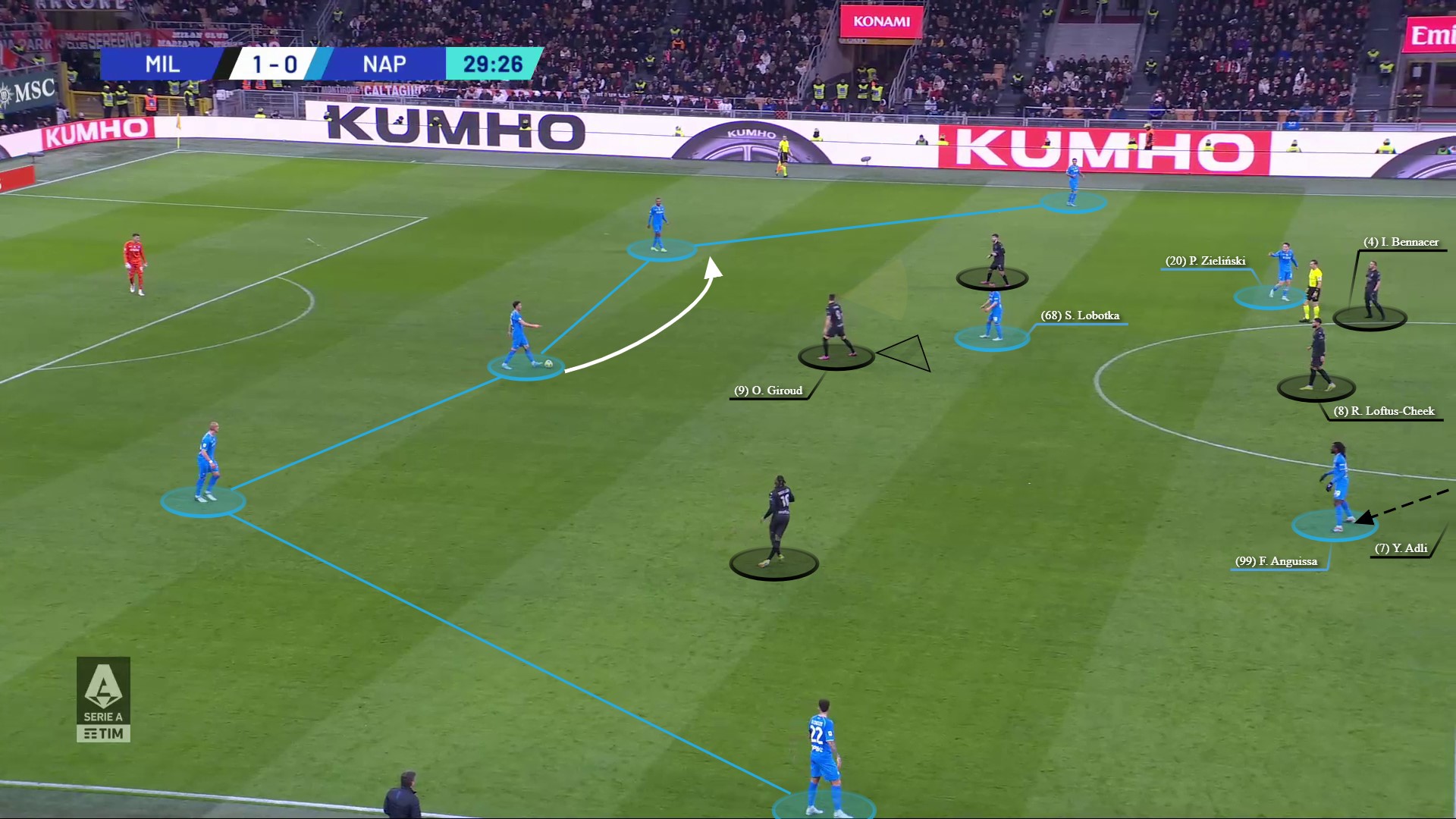

After the interval, however, Milan had to deal with a change of Napoli shape – with the visitors reverting to a 4-3-3. But the Rossoneri players all knew their roles.
The main differences were – Giroud’s responsibility was now the two opposition centre-backs and denying passes between them, in essence locking Napoli build-up onto one side of the pitch (again, setting the tone / signal for everyone behind).
This meant that the three Milan central midfielders all became much more player-orientated, including Loftus-Cheek who tracked Lobotka (or whoever was situated as the deepest lying midfielder). And finally, the Milan full-backs had less distance to cover, instead staying tight to the winger on their side – but still tucking in when the ball was on the far-side of the pitch.
Here’s an example from early in the second half of Milan not just adjusting to Napoli’s new shape but forcing a turnover.
Firstly, Giroud angled his approach to Juan Jesus to force play towards the opposition left – providing the signal to his teammates in the process, see Pulisic and Calabria already on the move. (Plus, all three Milan midfielders in close proximity to a Napoli counterpart).
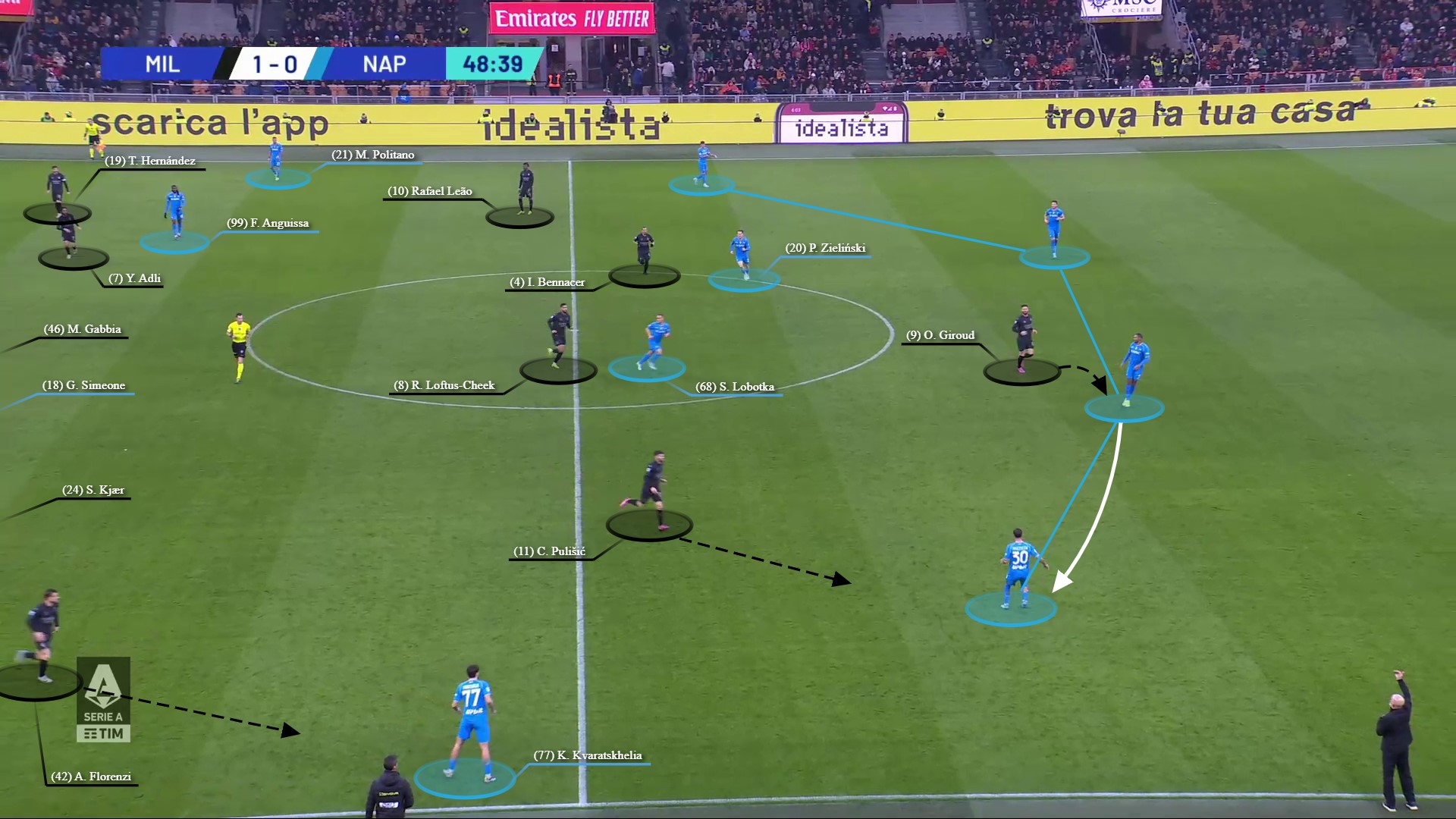
After receiving out towards their left-wing, Napoli decided to pass back inside to a momentarily free Rrahmani. However, one of the solutions Milan uses for their forward line (3 players) having an underload against a back four, is the far-side wide forward closing down from out-to-in the free opposition centre-back, so in instance – Rrahmani was quickly pressurised by Leão…
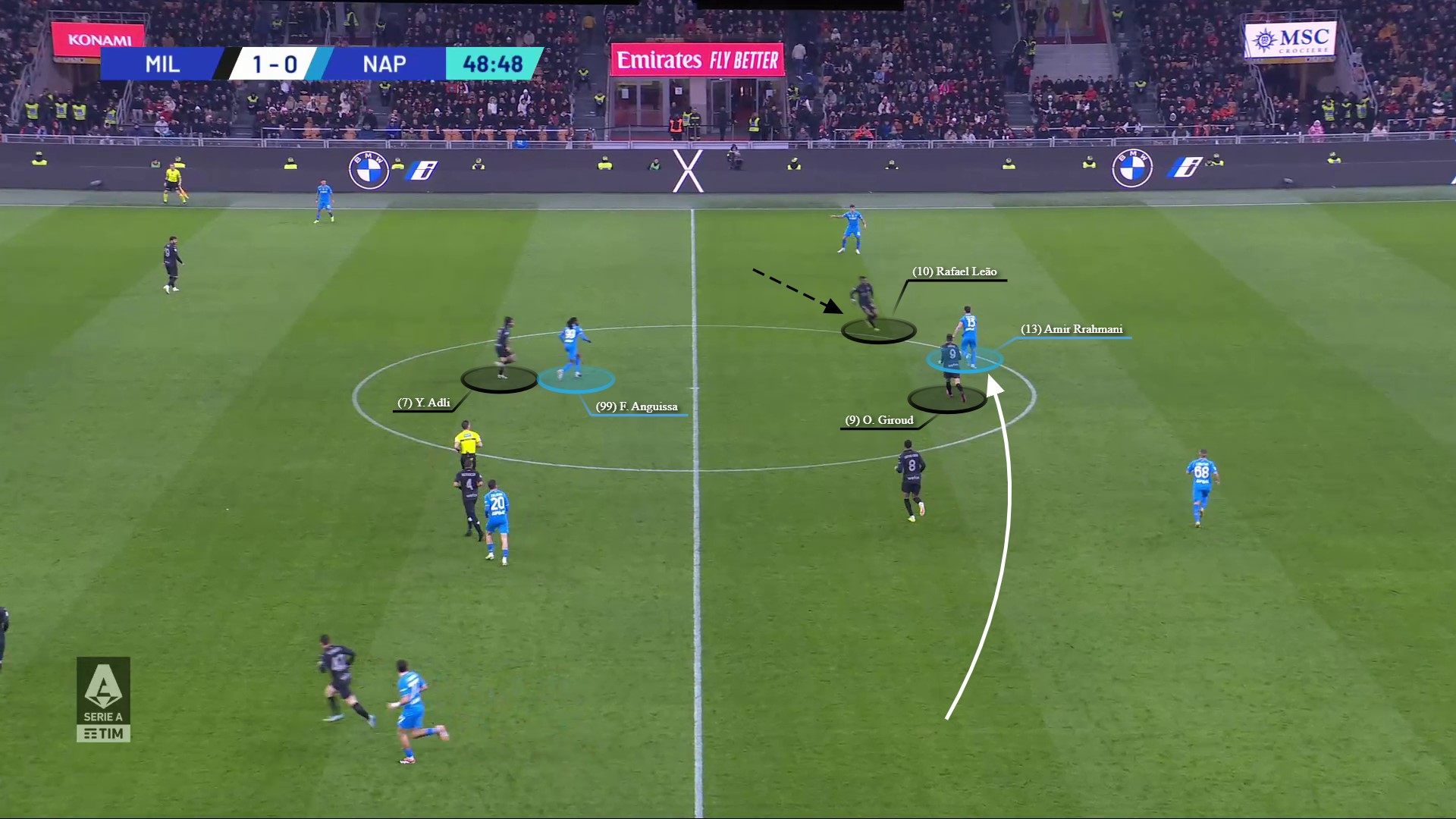
…and whilst the Milan forward didn’t win the initial ball, he helped his teammate Adli do so as he intercepted Rrahmani’s rushed pass into Anguissa. From here, Milan countered and Loftus-Cheek appealed for a penalty which was not awarded by the on pitch referee nor VAR.
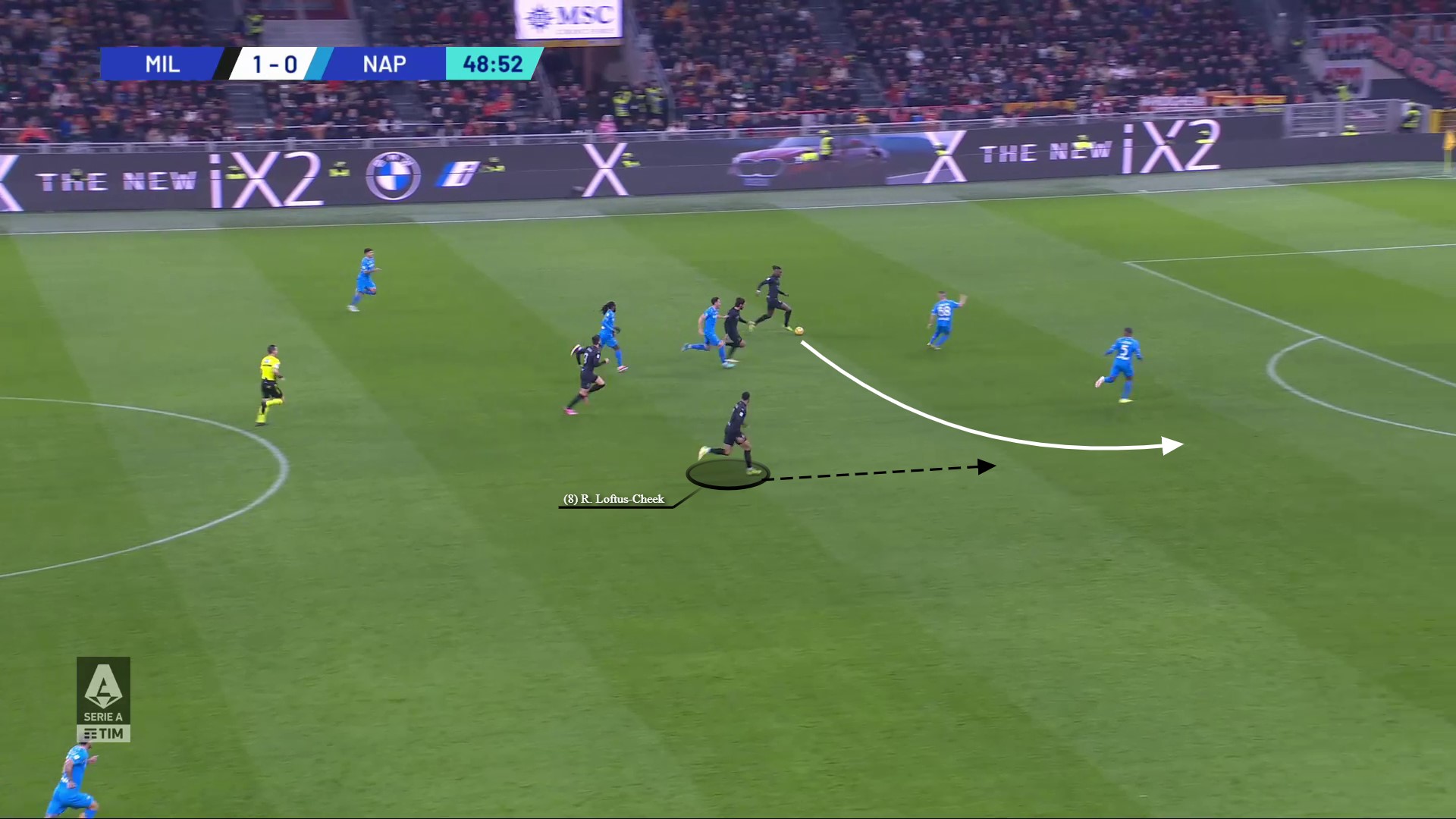
And Milan’s defensive organisation and work rate was their best attacking weapon in the second half. Here, in the 69th minute, Napoli went back towards their own goal from a throw in – a trigger for Milan to initiate their pressing scheme.
Giroud performs his role by ensuring Juan Jesus cannot pass laterally to his centre-back partner and Leão sprinted to get into a more suitable in-between position – so able to get out to either Di Lorenzo or Rrahmani.
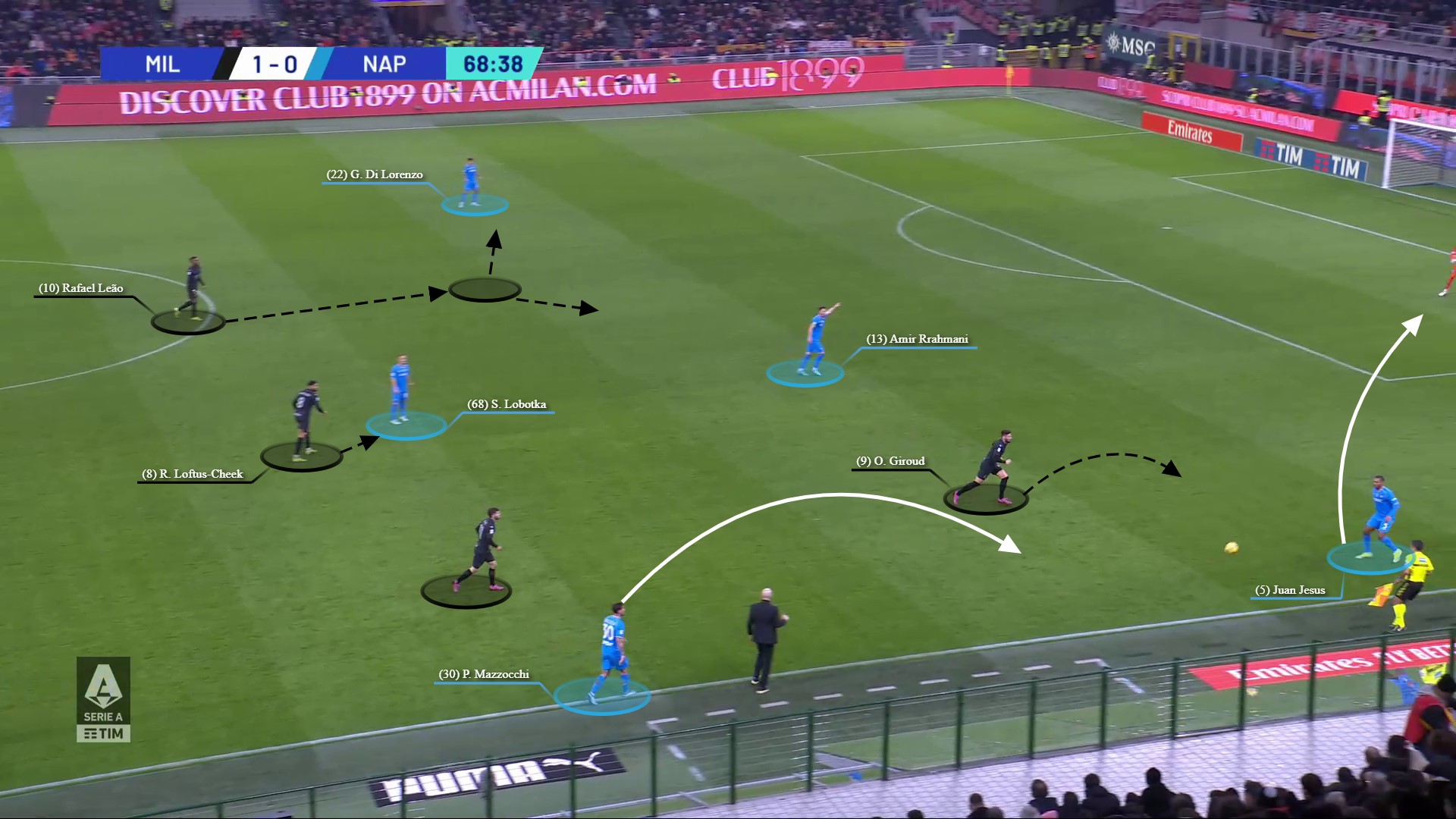
Napoli started their build-up with an attempt to play out via their right flank but Leão’s pressure on the ball, Hernández’s jump to stay tight to a dropping Matteo Politano (right winger), and no central access available, forced Napoli again back towards their own goal.
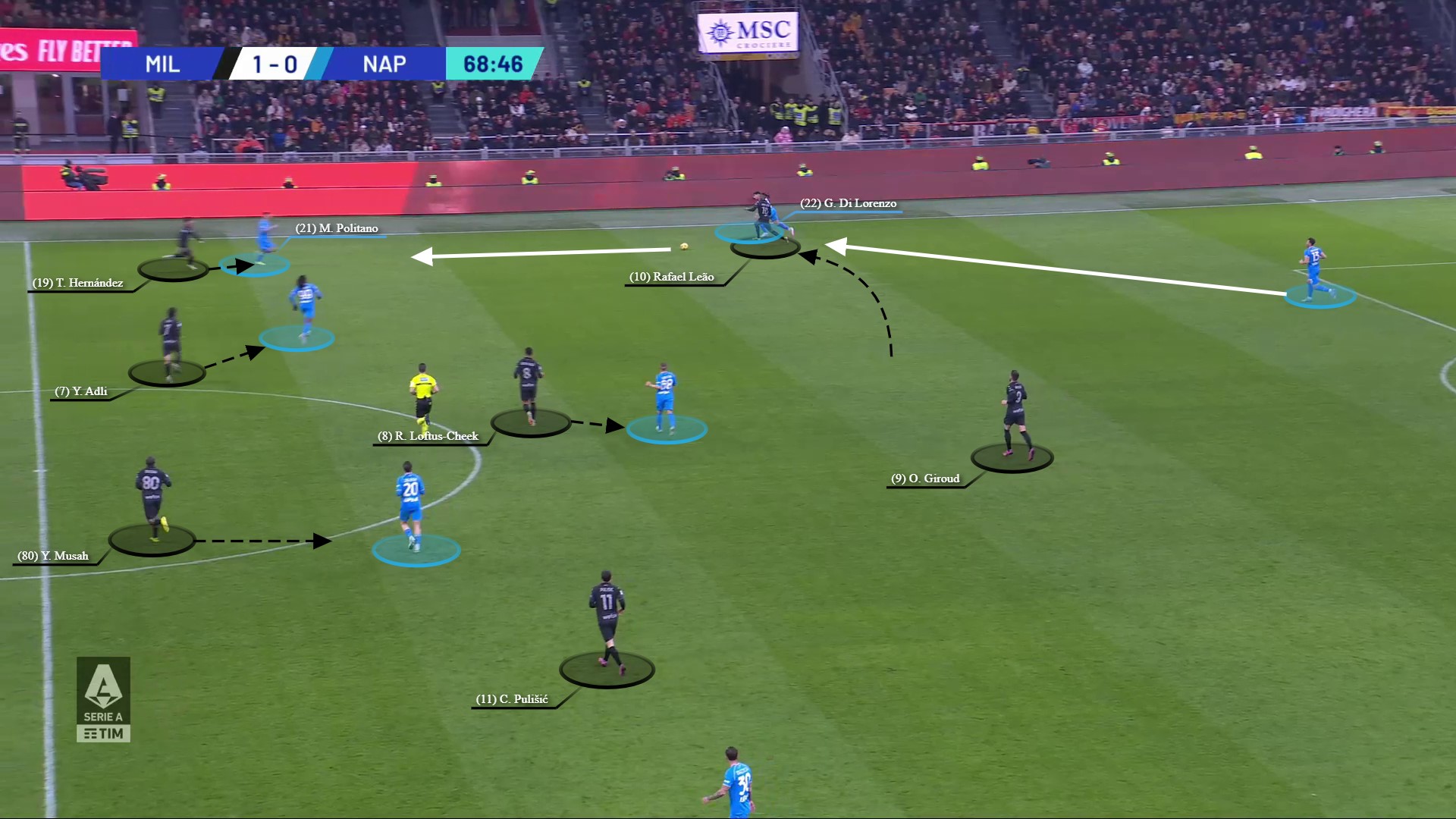
So as the recurring theme went, with no access up the one flank, try the opposite one. But after Mazzocchi attempted a pass infield to Kvaratskhelia, Alessandro Florenzi – picking up the baton from Calabria – was in close enough range to intercept…
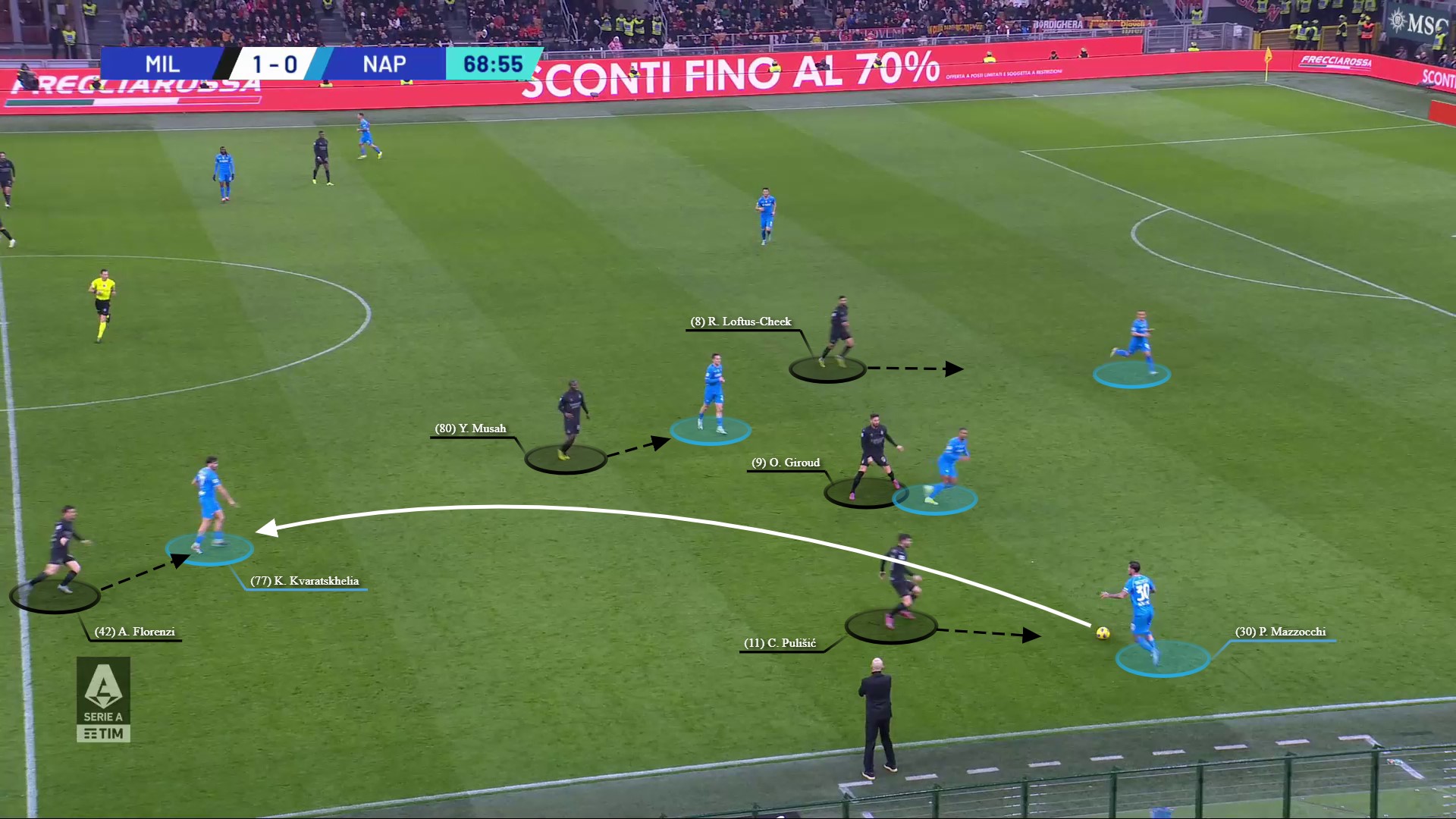
…and set Milan on the counterattack which ended with Leão cutting back onto his right foot and narrowly putting the ball wide of the far corner.
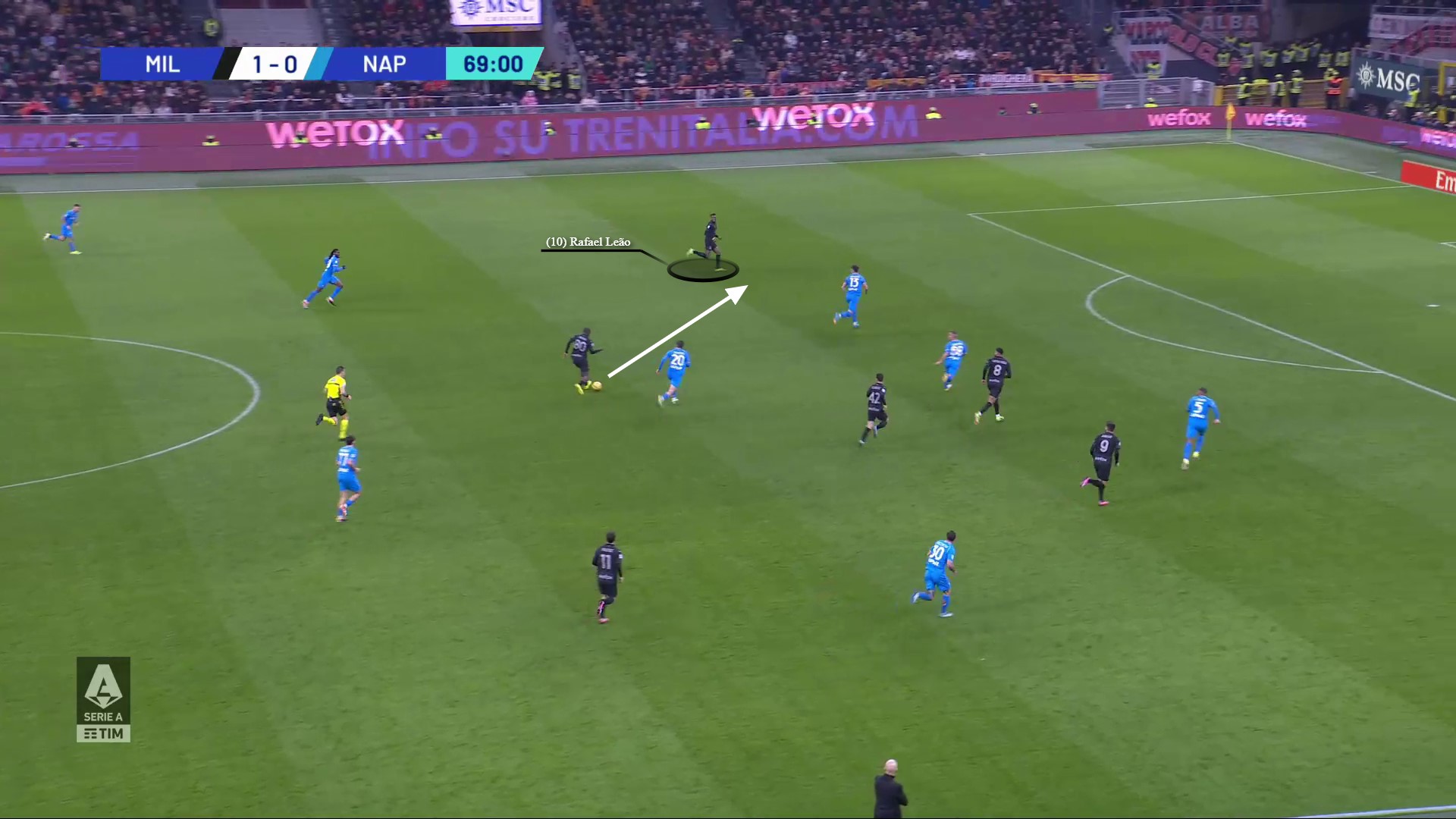
As the second half progressed, Napoli began to find more joy in accessing their free centre-back and this enabled the visitors to have more possession (62% of the ball, compared 52% in the first half). But as previously highlighted, Napoli did not create anything too threatening with it – with Milan more than playing their part in this.
Another factor in Napoli’s higher possession share was Milan’s tendency to go longer after the half-time break, reducing their effectiveness on-the-ball. With the away side pressing the hosts more, Milan opted to bypass the opposition press but a byproduct of this was more concession of the ball.
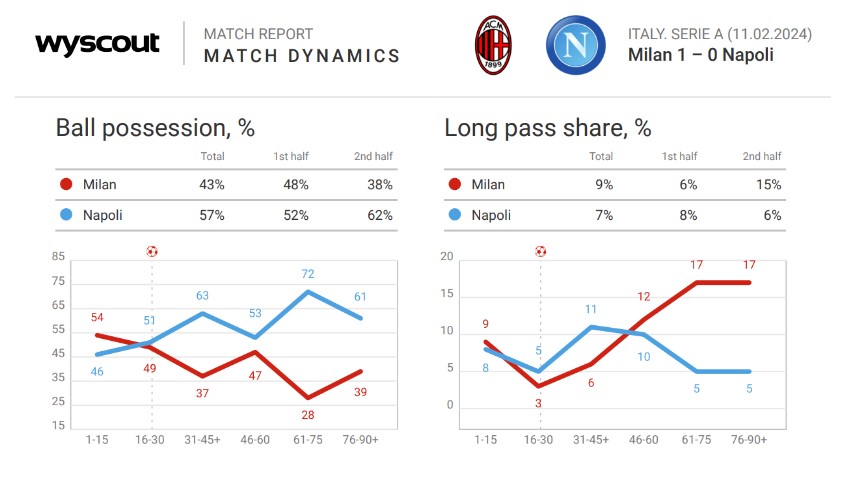
To see out the victory, Milan switched to a 5-3-2 in the closing stages with the biggest scare coming from the aforementioned Simic deflection which hit the post.
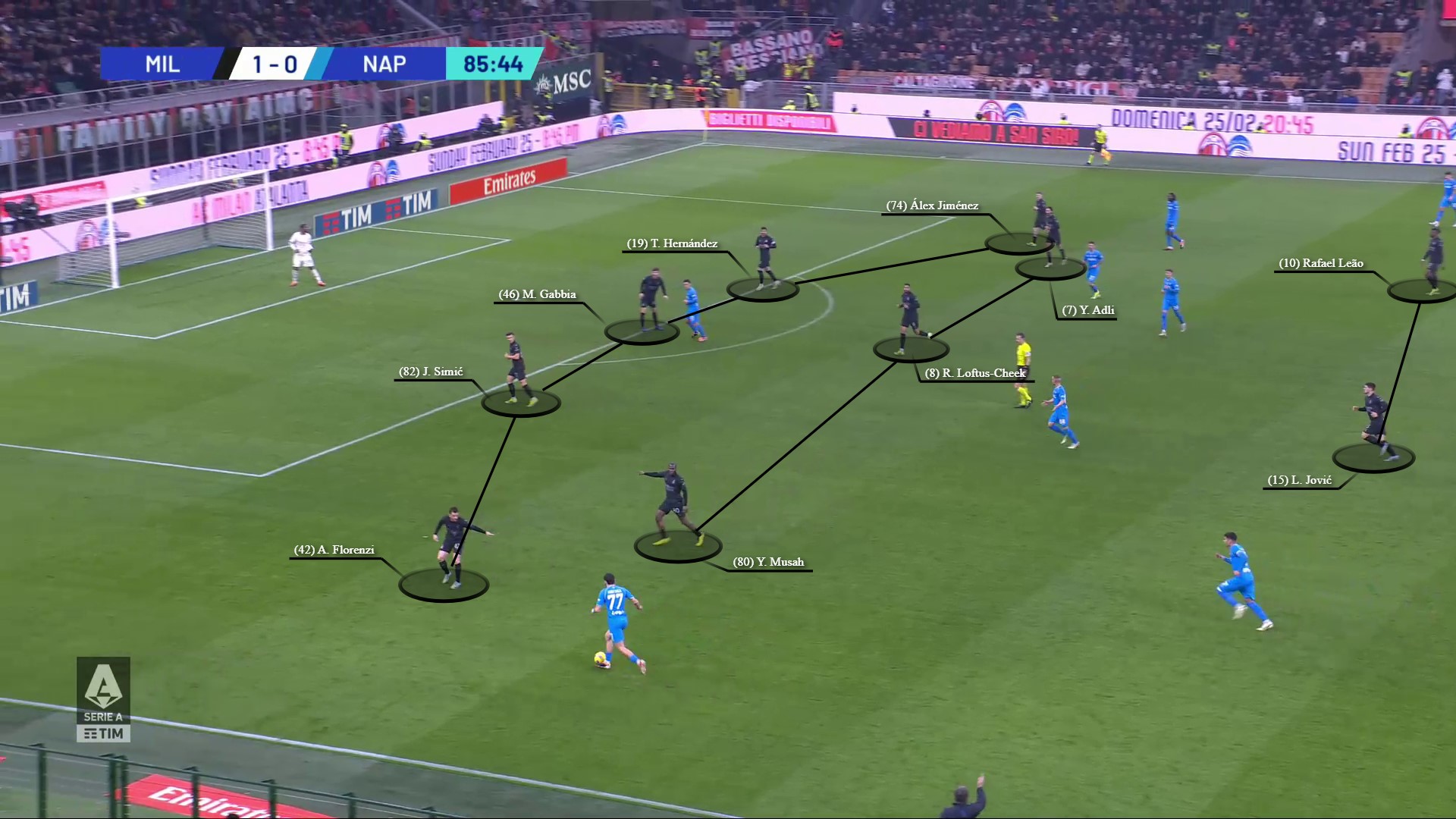
Away from the defensive phase, Milan did have opportunities to kill the game off through multiple counterattacks but failed to capitalise on these opportunities (but in the end, it wasn’t needed).
Looking up and ahead
The Rossoneri demonstrated improvements in the defensive side of their game to secure victory against Napoli, although a Victor Osimhen type profile will have likely provided the Milan defence with different questions to answer (threat in behind) and additional attacking quality.
But you can only beat what’s in front of you and Milan are now nine unbeaten in Serie A, firmly consolidating third place and diverting all eyes upwards and focused on overtaking Juventus in second place.
Before a trip to Monza this weekend, however, the San Siro will welcome Rennes for the Europa League knockout round playoff match first leg.

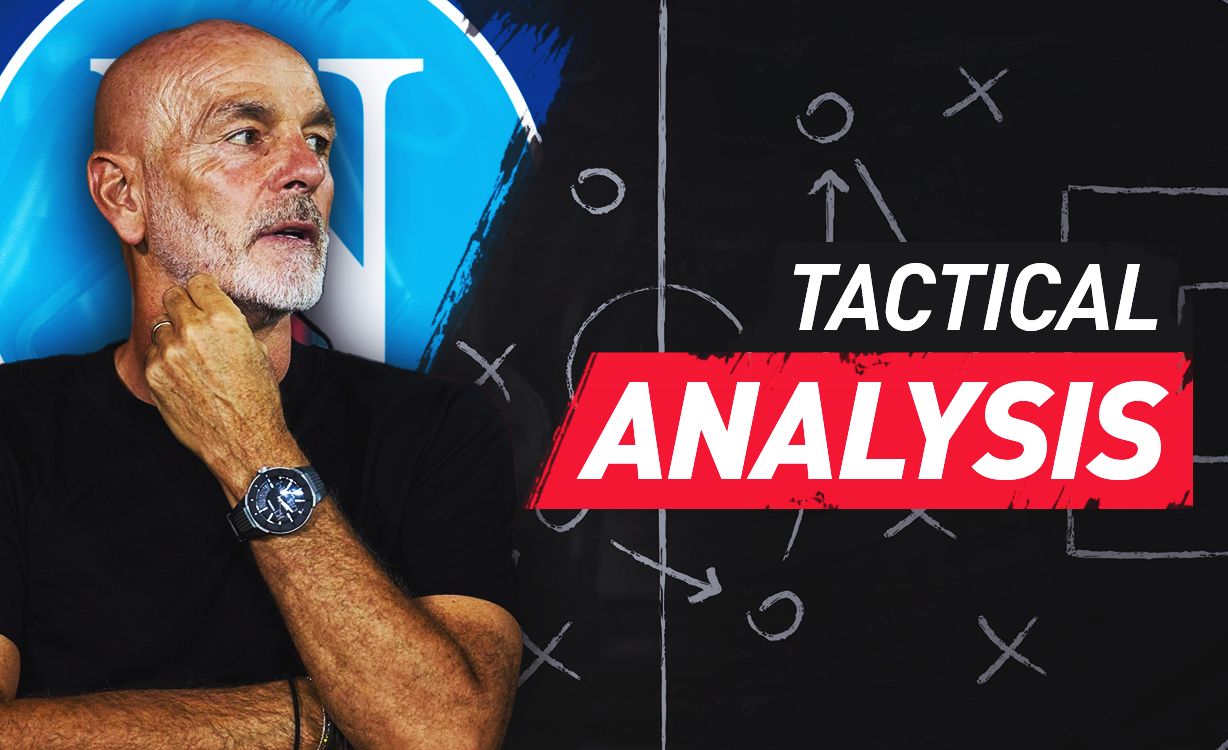
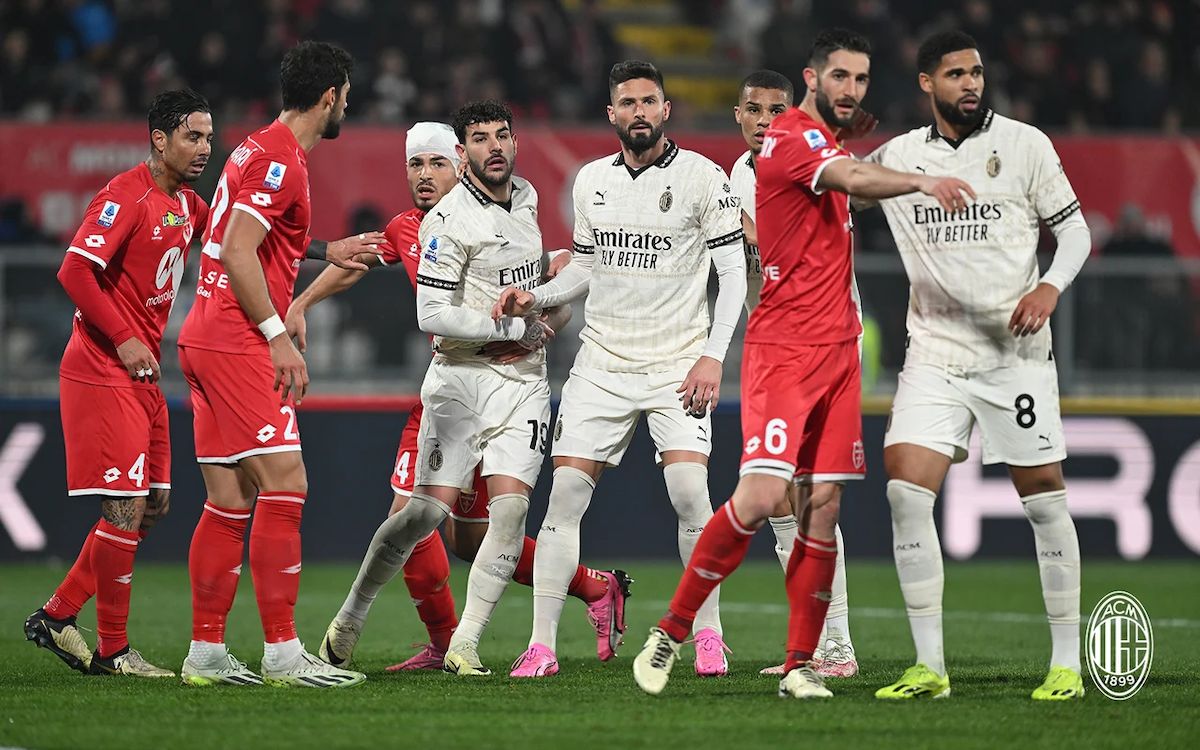
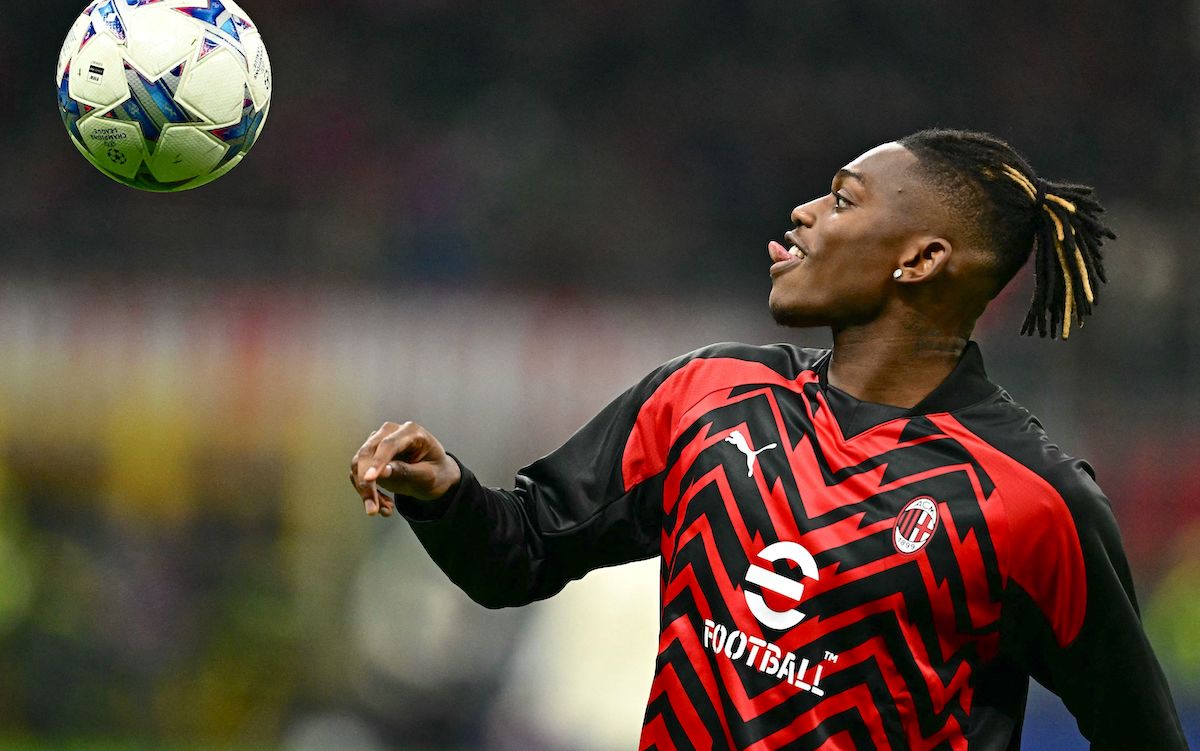


Giroud does everything right. For all the people on here that don’t see it and were complaining that Giroud does nothing every time he doesn’t score a goal. As this guy points out It was his wide run that opened up the space for Theo to get in behind. The little things that most people don’t see.
Also you can see how they have multiple people surrounding Kvara whenever he gets the ball, aside from the one time that he was left alone with Kjaer. Still we will have the people saying how Calabria pocketed Kvara…
yup, when Jovic played instead of Giroud, he hardly make any contribution and Milan struggled to attack. Milan’s attack is unfortunately dependent on Giroud.
Calabria did pocketed Kvara.
100%. Giroud isn’t perfect by any means, he can drop his head too quickly if things don’t go right for him, which is uncharacteristic for someone who’s so experienced. But generally, he’s a bloody winner. Fights for every ball, does the simple things right, and sacrifices himself for the team, which is a must in a team that relies on individual pieces of magic. Hopefully we keep him around cause Oli, Jovic and either Zirkzee/Sesko would be a great striker rotation to have if we’re going to compete on all 3 fronts next season.
and many said Milan don’t have a pattern, everything is based on individual brilliance .. you can’t do all this without a trained playing pattern ..
Interesting read